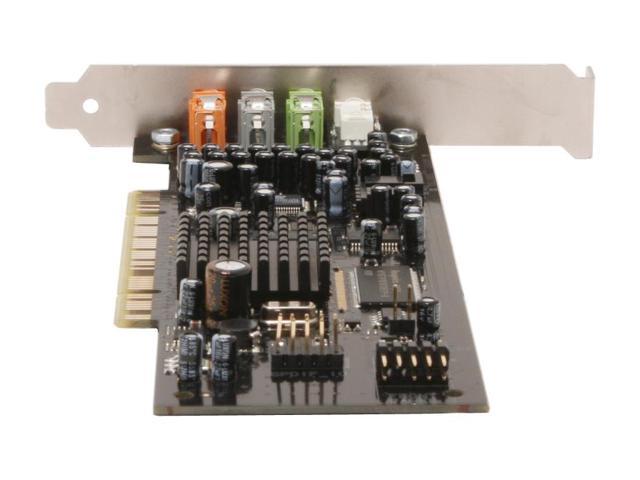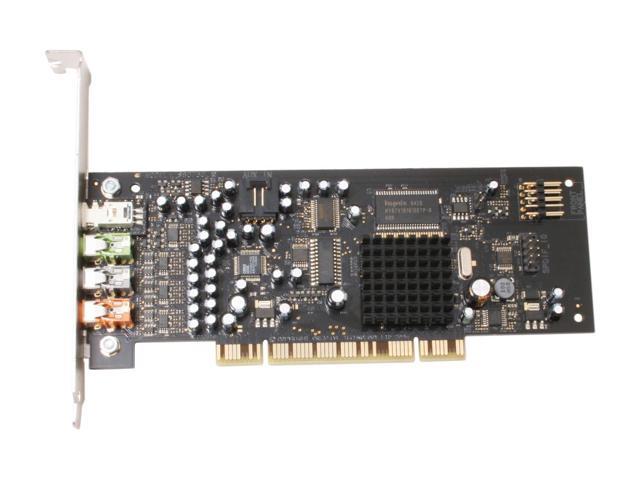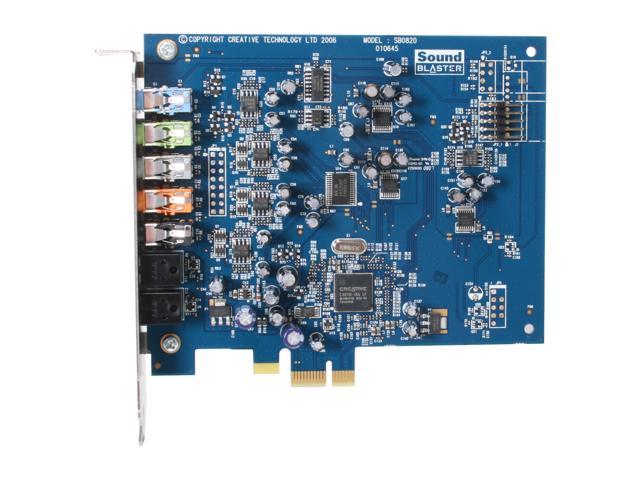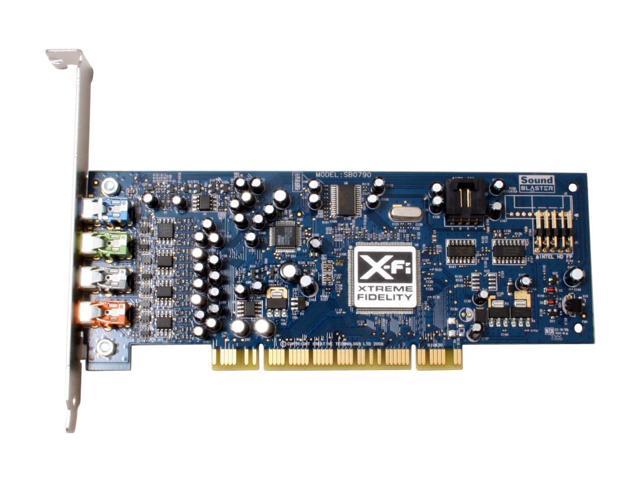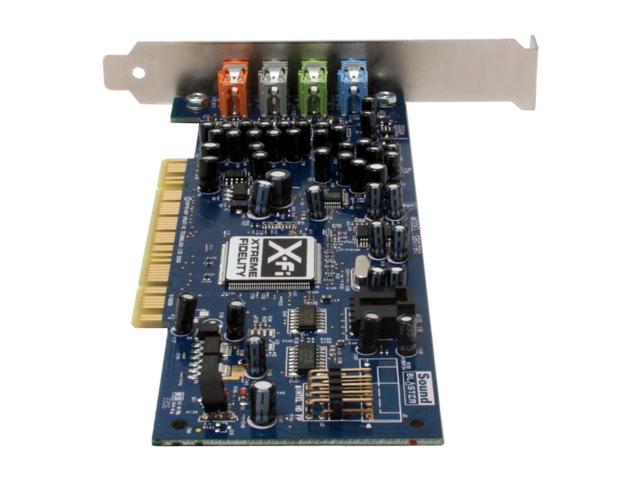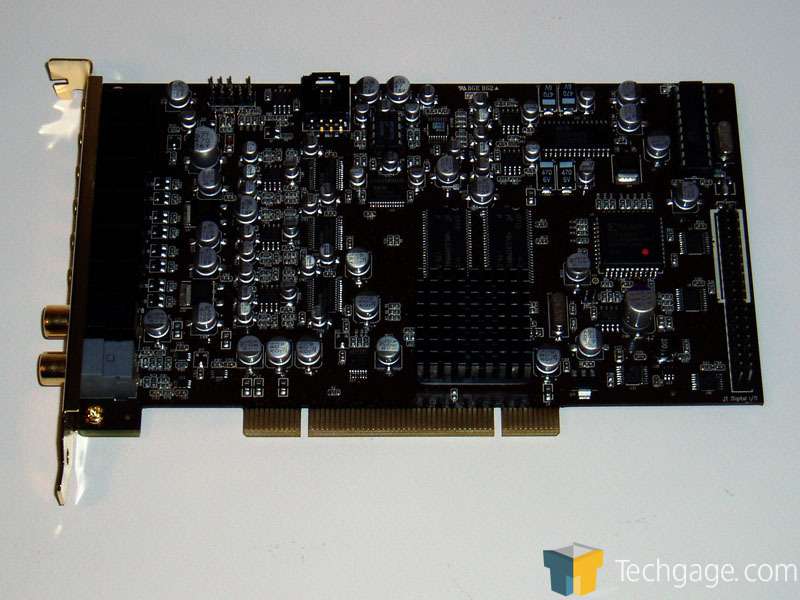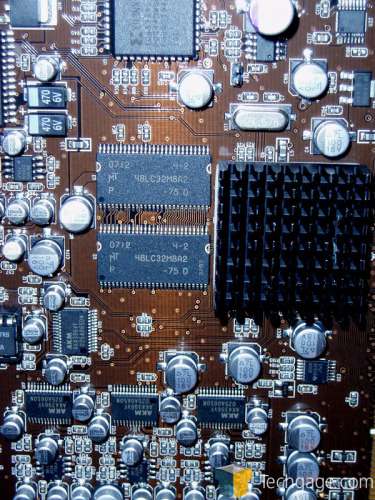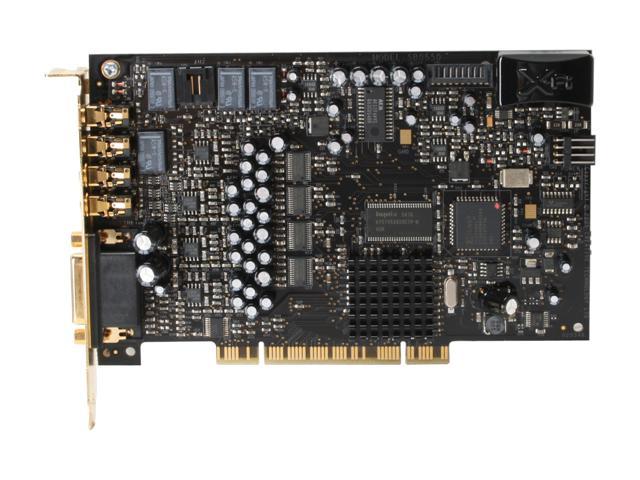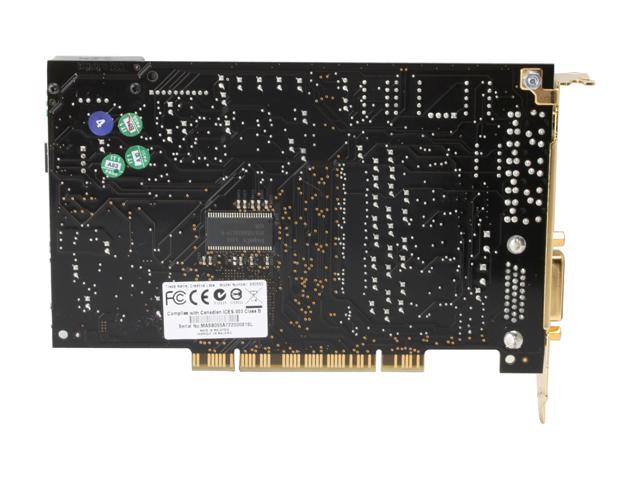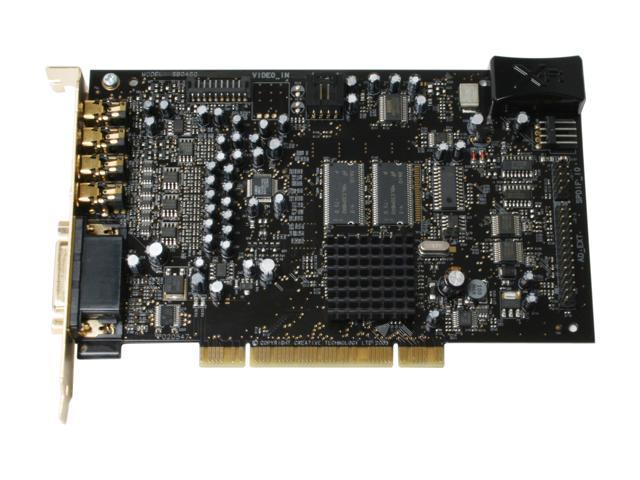imperialreign
New Member
- Joined
- Jul 19, 2007
- Messages
- 7,043 (1.15/day)
- Location
- Sector ZZ₉ Plural Z Alpha
| System Name | УльтраФиолет |
|---|---|
| Processor | Intel Kentsfield Q9650 @ 3.8GHz (4.2GHz highest achieved) |
| Motherboard | ASUS P5E3 Deluxe/WiFi; X38 NSB, ICH9R SSB |
| Cooling | Delta V3 block, XPSC res, 120x3 rad, ST 1/2" pump - 10 fans, SYSTRIN HDD cooler, Antec HDD cooler |
| Memory | Dual channel 8GB OCZ Platinum DDR3 @ 1800MHz @ 7-7-7-20 1T |
| Video Card(s) | Quadfire: (2) Sapphire HD5970 |
| Storage | (2) WD VelociRaptor 300GB SATA-300; WD 320GB SATA-300; WD 200GB UATA + WD 160GB UATA |
| Display(s) | Samsung Syncmaster T240 24" (16:10) |
| Case | Cooler Master Stacker 830 |
| Audio Device(s) | Creative X-Fi Titanium Fatal1ty Pro PCI-E x1 |
| Power Supply | Kingwin Mach1 1200W modular |
| Software | Windows XP Home SP3; Vista Ultimate x64 SP2 |
| Benchmark Scores | 3m06: 20270 here: http://hwbot.org/user.do?userId=12313 |
X-Fi Support Syndicate & Owner's Clubhouse
This is an owner's club and support thread for owners of Creative's line of X-Fi desktop and notebook audio cards. This thread is intended for people to be able to try and resolve issues with any hardware (and possible software) problems they might be encountering with their X-Fi products, and general discussion regarding the X-Fi lineup of audio cards and 3rd party audio cards making use of the X-Fi audio processors.
Please keep in mind that I am in no way trying to discourage anyone from buying a Creative X-Fi product!!! These truly are amazing sound cards, and you would honestly have to hear the difference to believe it. Plus, they are fairly priced, and readily available at any hardware outlet. Although it may seem that there are a lot of problems with these cards, the vast majority of users don't ever have any issues at all. There are just various quirks that one may possibly encounter, and I just wanted to try and bring as many issues and resolutions into one spot as possible because support information on these cards can be scarce.
If you wish to join, just say so - I'll probably make up an ongoing member list.
To join up, you must currently own (or have owned) a Creative X-Fi desktop or notebook audio card. Please state your X-Fi model or have it listed in you system specs when you ask for admittance.
I've also made a fairly simple signature that you're more than willing to use, if you'd like. I might make a couple more later, I'm not all that sure, yet.


PLEASE!! I'd like for this support thread to be fairly straightforward and easily accessible to not only TPU members, but for the general users just browsing the TPU forums. There are already way too many X-Fi related threads scattered across the internet that are stock full of tripe from either: a) the same question being asked over and over again, b) disgruntled users wanting to pitch a fit and complain about their product and lack of support, and c) thread-hijacks by users wanting to bash on either Creative or X-Fi owners . . . So - NO CRAP!! If you want to go bashing X-Fi owners, Creative's tech support (as difficult as they are to deal with), or just to whine and complain about your hardware with no real purpose or a genuine intent to find an answer - go register at another message board! It's difficult enough to find answers resolving hardware complaints without having to shovel through a sea of tripe.
That being said, I will try to keep up a list of common and uncommon problems and their resolutions, along with posting up rare or odd problems and possible work arounds. Please, keep in mind that these audio cards are constantly evolving, and due to various differences between the audio cards, and individual user hardware and system configurations, any solution I may present to a certain issue may not fix your problem. I cannot give 100% guarantees with hardware resolutions concerning these audio cards, all I can do is present information that I and others have had success with. My intent is to provide a 'knowledge base' for help, in a manner where others can also be willing to help resolve issues if they can. I will update the list of resolutions as I come across them, too . . . I'm willing to try and help with software issues regarding Creative's software, but these issues can be even harder to fix for numerous reasons, and it is usually best to contact Creative's Technical Support regarding their software.
I, nor any other member of this forum, shall be held liable for any damage done to, or any loss of warranty to, any of your hardware, X-Fi or otherwise, by following any posted solutions or advice in this thread!!! If you don't feel comfortable using any resolution or workaround to a problem you encounter, please seek the aide of a professional!
Also, these lists are far from complete, and I will add to them as I have time, and as I run across other situations/solutions that aren't just a one time deal. If anyone would like to add something to the lists, or if you see something that needs to be corrected, please let me know (if you are offering a correction for the X-Fi audio card hardware, could you please provide a link to a reputable source for the information you provide).
Foremost, to any aide that I can offer, there are a couple of major points that need to be emphisized:
1. Make sure your motherboard's on-board audio is turned off, and the hardware drivers are removed (if possible)!!
2. Make sure your Creative hardware drivers are as up to date as possible! If for some reason you can't use any updated drivers provided by Creative, just explain what the problem is - it's usually a hardware problem.
3. Make sure your hardware drivers for the rest of your system are as up to date as possible! General hardware conflicts can arise with out of date drivers!
The most common, re-occuring hardware complaints with the X-Fi's are usually resolved by one of the aforementioned items!!
~~~~~~~~~~~~~~~~~~~~~~~~~~~~~~~~~~~~~~~~~~
Update to thread: 03-11-09
`added an image for the Auzentech X-Fi Home theater 7.1
Update to thread: 07-18-08
`added the Titanium series to the product list
`added Auzentech cards to the product list
`added some info on the new CA20K2 APU
Update to thread: 05-12-08
`edited some used terminology
`added to the "Modding" section; cooling, front panel connectivity, PCB component upgrading, EMI/RFI shielding
Update to thread: 04-02-08
`added information describing the ring architecture
`added diagram for ring architecture provided by btarunr
`resized this update section so that it doesn't get out of hand!
`reminded myself that I need to make some more updates this coming weekend!
Update to thread: 30-01-08
`added new siggie
`concluded to add support for the Auzentech X-Fi Prelude 7.1 - I will add a section for that card soon
Update to thread: 25-01-08
`added description of ALcehmy driver operation by btarunr
`added mention of 3rd party software for use with X-Fi remote by tigger69
`anotated a possible issue with current beta drivers and UT3 by Batou1986
Update to thread: 18-11-07
`added audio quality section
Update to thread: 10-11-07
`added update section
`added model section and model pics
`added section dividers
`adjusted section headlines
~~~~~~~~~~~~~~~~~~~~~~~~~~~~~~~~~~~~~~~~~~
The most current hardware drivers can be found at Creative's website - note that the Xtreme Audio cards use entirelly different driver packs than the rest of the X-Fi family. (Vista32 & Vista64 current version is 2.18.0008; XP32 & XP64 current version is 2.18.0008; XP MCE current version is *possibly* 2.18.0008 - see #13 below for further details concerning the update drivers and MCE):
http://us.creative.com/support/downloads/
==================================================================
Up-to-date driver version numbers:
Windows XP / Vista drivers
current XP version is: 2.18.0008
*last driver update: December 17, 2008
current Vista version is: 2.18.0008
*last driver update: December 17, 2008
Windows XP /Vista drivers for the X-Fi Titanium series -
current XP version is 2.18.008
current Vista version is 2.18.008
Linux 32bit/64bit drivers
current linux driver version is: 1.00
*last driver update: November 6, 2008
Linux 32bit/64bit drivers for the X-Fi Titanium series
current linux driver version is: 1.00
*last driver update: November 6, 2008
X-Fi Xtreme Audio current driver number for both WIN XP and Vista: 1.3.02
*last driver update: December 12, 2008
================================================================
If your concern is related to sound playback with a game, please make sure you have the most current version of DirectX installed, and the most current version of OpenAL:
DirectX version 9c - https://www.microsoft.com/downloads...38-db71-4c1b-bc6a-9b6652cd92a3&displaylang=en
OpenAL 1.1 (version 2.0.3) - http://developer.creative.com/articles/article.asp?cat=1&sbcat=31&top=38&aid=46
Attention Vista users: The X-Fi drivers for Windows Vista are still going through a lot of changes. New drivers are released for the Vista platform fairly regularly, so please try to keep up to date. Support for the Vista platform is continuing to improve, but I have no ability to aide in Vista related problems as I currently have no experience with this platform. Again, make sure your drivers are current. I will try to also include Vista related fixes here also. Hardware acceleration in Vista is disabled by the OS, although there are developmental drivers that attempt to work around this issue (these are constantly being updated, also):
ALchemy software application (current version is 1.10.01) - http://www.soundblaster.com/alchemy/
a very concise, to-the-point explanation of how the ALchemy software works around the hurdle of the OS Kernel to deliver multichannel support, provided by btarunr:
~~~~~~~~~~~~~~~~~~~~~~~~~~~~~~~~~~~~~~~~~~
A Brief summary of X-Fi technologies and features:
X-Fi audio processor:
The X-Fi CA201K audio processor is manufactured on a 130nm process, is clocked at 400MHz and utilizes over 51 million transistors that are capable of producing over 10,000 MIPS (Million Instructions Per Second). In comparison, an AMD Athlon FX-57 is capable of producing 12,000 MIPS at 2.8GHz, and an Intel Pentium 4 Extreme Edition produces only 9,726 MIPS at 3.2GHz. The X-Fi audio processor features a SRC (Sample Rate Conversion) engine that is precise enough to be able to convert any audio resolution to any other audio resolution at near transparency with 136db SNR (Signal-to-Noise Ratio) THD+N (Total Harmonic Distortion + Noise) and digitally-matched recordings at rates from 44.1kHz to 96kHz. According to Creative's literature, the X-Fi audio processor is over 24 times more powerful than it's predecessor, the Audigy 2. For further reading regaring the capabilities of the X-Fi audio processor and how it's architecture works, visit: http://techreport.com/articles.x/8884
The X-Fi CA20K2 audio processor appears to be designed off the same manufacturing process as the CA201K APU, with the only major notable change being that the CA20K2 is a native PCI-E processor . . . meaning it will not have to rely on a PCIE translation chip for BUS communications, which would severelly impact audio processing latencies. Little is known of this APU at the moment, more info will be added as it surfaces.
CMSS-3D Virtual / CMSS-3D Headphone:
Creates up to 8 virtual speakers in order to achieve a surround sound effect for gaming and entertainment purposes where surround sound speakers are not available. The X-Fi algorithms upmixes the source and places the sound in it's most natural position. Basically, the hardware can break down a 5.1 channel source, upmix it, and reproduce that source into a 2 channel feed in such a way that it still sounds like 5.1. The capability of the CMSS-3D technology is more noticeable with headsets and 2.1 audio, and becomes increasingly harder to notice as one move up to 7.1 speaker setups. For a slightly more in-depth description of how CMSS-3D works, visit: http://www.pcper.com/article.php?aid=177&type=expert&pid=6
EAX 5.0 HD:
Environmental Audio eXtensions v5.0 High Definition is an assortment of DSPs (Digital Signal Processing) audio presets that utilizes the audio card's hardware filters to produce highly realistic and immersive sound, enviornmental effects, improved audio positioning, and a improved cinematic sound in games. This feature is inteded to add to the realism and overall effect of gameplay. The EAX 5.0 HD standard brings even more features to the table than the 4.0 standard did, and allows for double the voice count over EAX 4.0. For further reading regarding the capabilities and features of the EAX 5.0 HD design, visit: http://soundblaster.com/eax/abouteax/
X-RAM:
*All Creative X-Fi cards have some amount of onboard memory. The amount of onboard memory varies based upon the card model and revision, with RAM allotments ranging from 2MB to 64MB. The audio processor needs a small amount of memory for storing the APU BIOS, buffering, sampling and playback, and the more memory, the more voices and audio files the APU can handle at a time. The upper-end X-Fi models, are advertised as having 64MB or X-RAM, which really only means that they have 64MB as compared to lower models that may only top out at 32MB.
Found on the upper end cards, the X-RAM is 64MB of RAM native to the audio card, and dedicated soley for use by the X-Fi processor. In theory, the X-RAM would allow for improved gaming performance by unloading much of the audio memmory access from the system hardware and permitting the X-Fi to take over duties of moving audio files into and out of it's own onboard RAM. This would free up more space in the system RAM for use by the CPU, and transference of audio data would be minimized and audio files could also then be loaded and unloaded quicker by the audio processor. Although, only a handful of games currently support use of the X-RAM technology, and support by game developers has been slow to near non-existant. For further reading regarding how X-RAM works, visit: http://www.soundblaster.com/products/X-Fi/technology/x-ram/gamingXram.asp?page=3
24bit Crystalizer:
The 24bit Crystalizer is a processing innovation that is designed to enhance and restore lost information in the audio spectrum due to compression from an audio source, namely MP3s. The Crystalizer attempts to restore those sounds that are lost during compression to bring the MP3 audio sound back to or surpass it's original CDDA form. For gaming, the Crystalizer can bring not only a more crisp sound, but aslo enhance audio depth that can normally be lost through typical sound compression. Although the Crystalizer does, to some extent, do what it is advertised as being capable of, the actual validity of these claims has come under scrutiny. A rather interesting read regarding the Crystalizer technology, and what it's capabilities truly are, can be found here: http://www.digit-life.com/articles2/multimedia/creative-x-fi-part2.html
Ring architecture:
The X-Fi cards use an entirelly different architecture as compared to earlier Creative lineups and their competing cards. Whereas in a typical audio processing stream, components are arranged within a straight line. This type of architecture severelly limits both the number of audio voices that can be processed at a time, and also hampers the overall performance in regards to the amount of time it takes for that voice to be processed from source to playback. The X-Fi's make use of what Creative calls a "Ring BUS" architecture, where all processing components on the PCB BUS are arranged like that of a ring. Each component in the ring can pull the processed audio voice, manipulate it, and place it back into the ring for the next component to access. This design, in turn, allows for thousands of audio voices to be processed simultaneously, and to also be processed faster. If a component does not need to manipulate an audio voice, it never has to come into contact with the processed stream.
btarunr has illustrated in a fairly easy to understand diagram how this architecture works:
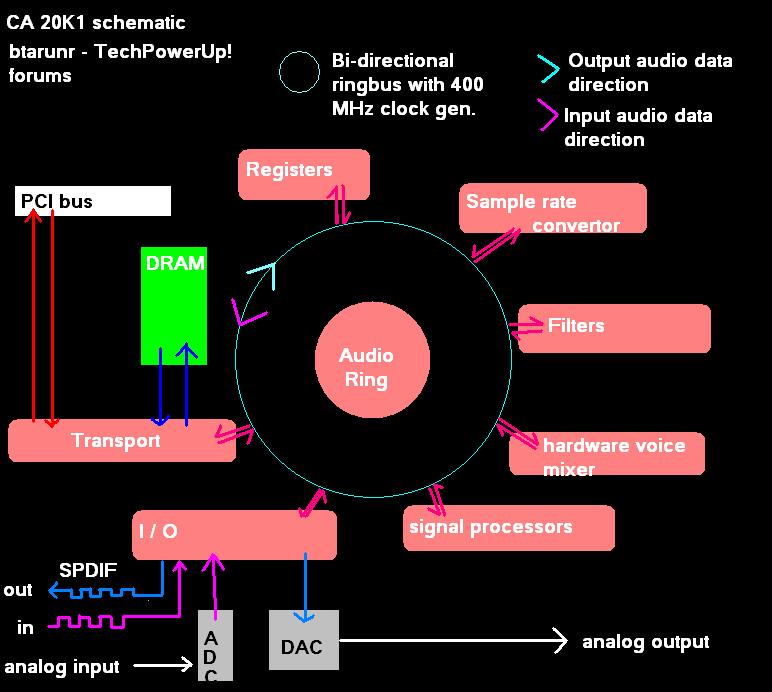
~~~~~~~~~~~~~~~~~~~~~~~~~~~~~~~~~~~~~~~~~~
Creative X-Fi Sound Blaster Models
Sound Blaster X-Fi Xtreme Audio PCI
The Xtreme Audio is the cheapest of the X-Fi lineup as far as price in concerned. If you’re in the market for a simple audio adapter card, and music and videos is your thing, this would probably be the best choice. Not really recommended for serious gaming, considering this card is designed more for the home entertainment market, and lacks some of the gaming features and support that stand out on the other models. Features CMSS-3D, 24-bit Crystallizer.
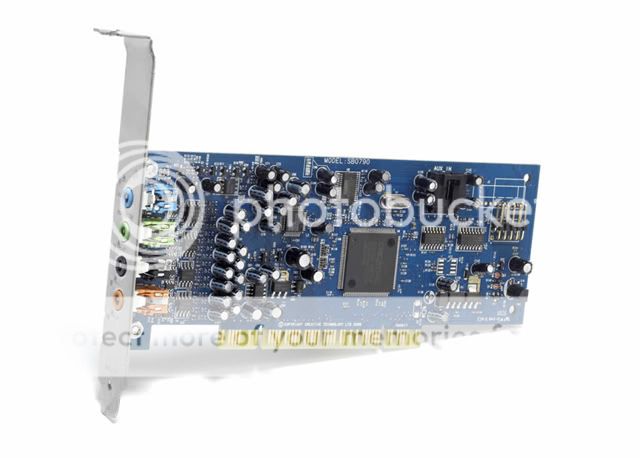
Sound Blaster X-Fi Xtreme Audio PCI-Express
This card offers the same features as the Xtreme Audio PCI, although it utilizes a PCI-E x1 interface. One of the few pieces of hardware on the market that make use of the PCI-E x1 slots so common on motherboards. This might be alright for mini-towers where space is a major concern, or anyone looking for a solution for a multi-GPU rig. Due to poor reviews, and potential problems with multi-GPU setups and mid-range motherboard chipsets, I honestly can’t recommend this card, yet.
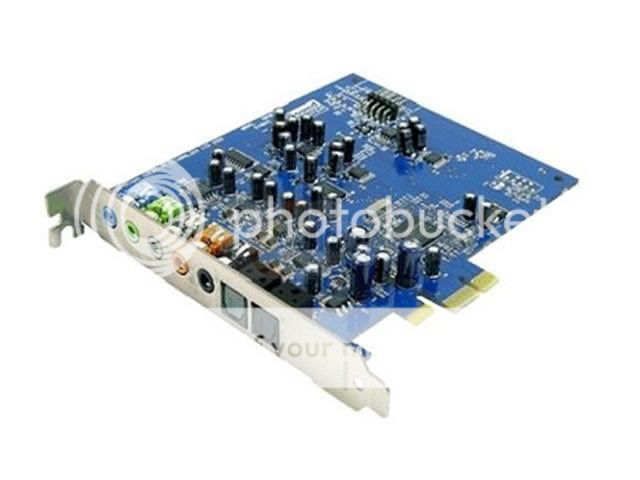
Sound Blaster X-Fi Xtreme Gamer PCI
The Xtreme Gamer is targeted specifically at the gaming market, and also serves as a great card for video and audio playback, and audio “tweaking”. Not recommended if you’re looking for a card that can handle serious audio creation. This Xtreme Gamer features Creative’s CMSS-3D, support for EAX 5.0HD, and the 24-bit Crystallizer.
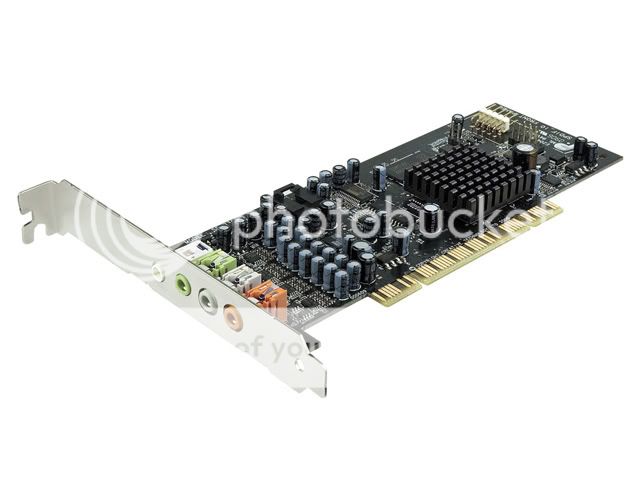
Sound Blaster X-Fi Xtreme Music PCI
The Xtreme Music was targeted at audiophiles in general, and also has features catered towards the gaming enthusiast. This model was supposed to pick up where the Xtreme Gamer left off in the line-up, by offering better audio creation support. I believe this card, though, has been superceded by the X-Fi Platinum.
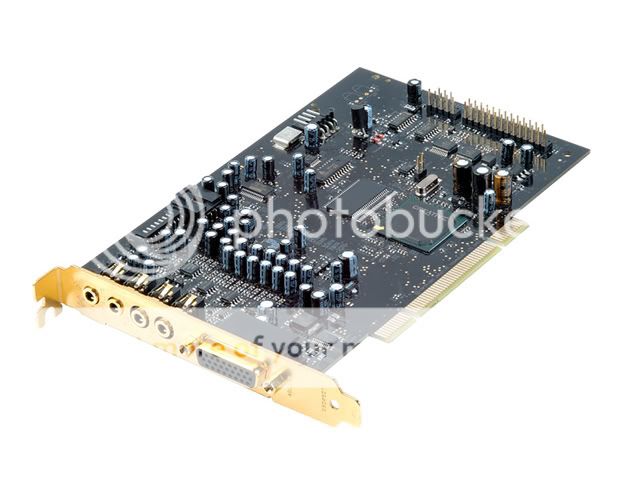
Sound Blaster X-Fi Platinum
The X-Fi platinum is a package deal. It comes with the Xtreme Music PCI card, plus adds the X-Fi I/O Front Panel Drive and a X-Fi Remote Control. The Front Panel Drive utilizes a 5.25” drive bay, and allows for easy input and output jack access and adjustable volume control.
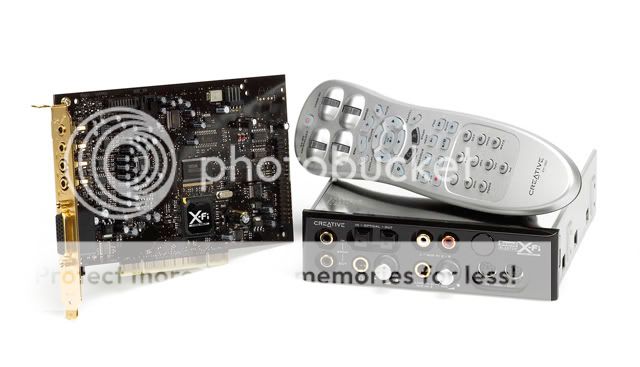
Sound Blaster X-Fi Xtreme Gamer Fatal1ty Pro PCI
The XGFP is the flagship of Creative’s line-up, boasting full-feature support in all 3 areas (gaming, entertainment, audio creation), and also bringing in 64MB of X-RAM, power indicator LEDs, I/O support, and more. This card is targeted at the audiophile, and those who are looking for the absolute best sound card solution. Until the Auzentechs were released, this was the definitive audio solution. Still capable of competing and surpassing the lower-end models offered by Auzentech, though, I personally recommend this card to anyone looking for the best solution possible, while still being on a budget.
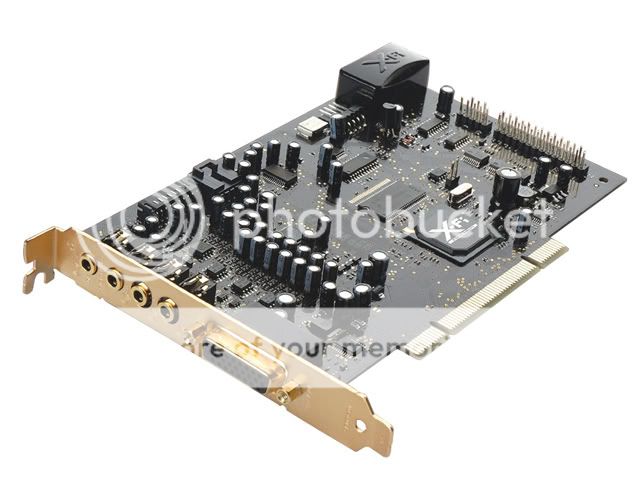
Sound Blaster X-Fi Platinum Fatal1ty Champion
This package includes the Xtreme Gamer Fatal1ty Pro PCI card, plus the I/O Front Panel Drive and remote.

Sound Blaster X-Fi Elite Pro
This package includes the flagship X-Fi card, plus the I/O Console and remote. The I/O console offers the same connect ability that the Front Panel Drive offers, but instead attaches to the back of the card and can be placed remotely. The I/O Console is targeted more at a home entertainment setup, in this respect. The Elite Pro sound card is the current highest audio playback quality card in the lineup, and is a completely different beast from the rest of the X-Fi models, right down to PCB components and component layout.
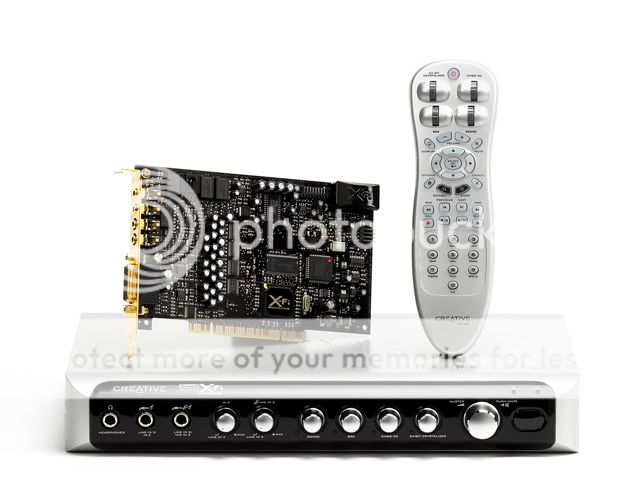
Sound Blaster X-Fi Titanium Fatal1ty Professional
The most recent X-Fi branded card to enter the Sound Blaster line-up, the Titanium is a native PCIE x1 soundcard; being native PCIE, there is no additional audio processing latecny that would be introduced with a PCIE logic translation chip. The card boasts the same audio quality specifications as the Xtreme Gamer Fatal1ty cards, and improves upon that with the addition of an EMI shield. This card, though, drops support for the AUD_LINK to the X-Fi reciever from the PCI bracket, and instead adds optical (TOSLINK) support, as well as offering 5 analogue jacks instead of 4 (subwoofer is now a seperate channel). The Titanium is also the first X-Fi card that allows for Dolby encoding as well.

Sound Blaster X-Fi Titanium Fatal1ty Professional Champion
This package option offers the X-Fi Titanium PCI-E x1 soundcard, and the new X-Fi Titanium Front Panel I/O bay drive. Of note, the new I/O bay drive will readily fit a 3.50" bay, and also includes an adapter to fit a 5.25" bay, allowing for better installation versatility as compared to the earlier X-Fi I/O bay drives. The new drive has seriously timmed down connectivity, though. The 3.50" drive itself offers headphone-out and microphone-in mini-jacks, a volume knob, and a mode selector knob (>correction?<); the 5.25" adapter adds two RCA line-outs to the drive.

Non-Creative X-Fi equiped cards:
Auzentech X-Fi Prelude 7.1
Auzentech have made a name for themselves for selling extremelly high-quality audio cards that offer superior versatility and superior audio quality as well. Combined with excellent customer and technical service, Auzentech have cemented themselves within a niche in the audio card market. The Prelude is the first non-Creative owned audio card to carry Creative's hardware. The Prelude boasts the X-Fi CA201K APU, and brandishes the typical high-quality components that Auzentech have become known for. Amidst the upper-end DACs, ADC and OPAMPs, the Prelude even even boasts the ability for the user to swap OPAMPs as they see fit - giving the consumer a DIP socket instead of hard-soldering the OPAMPs to the PCB. These cards feature the audio processing performance that the X-Fi APU has become known for, and offer all the hardware features of Creative's cards. They also support Dolby decoding and encoding as well.

Auzentech X-Fi Home Theater 7.1
A new card still in the works from Auzentech, again featuring a X-Fi APU. The card will make use of a PCIEx1 slot (rumored to make use of the new CA20K2 native PCIE APU), and will offer HDMI 1.3 support. More information and an image will be added as they become available. This card is not yet on the market, scheduled for release early 2009.

For owners who have the X-Fi remote found with the 5.25" bay front panel and the I/O Console, 3rd party software exists that offers better compatibility and functionality over Creative's bundled software:
~~~~~~~~~~~~~~~~~~~~~~~~~~~~~~~~~~~~~~~~~~
Common Problems and possible resolutions
Poor Audio Quality
It goes without saying, but, if audio playback is poor quality, or not what you expected - keep in mind that your speaker setup has more to do with audio quality than the sound card does. You can have the best audio card in the world, but it can still sound like total butt running on a cheap set of lacklustre quality speakers. Same holds true for headsets. Some thoughts here:
~Built in monitor/keyboard speakers - are fine for browsing the net or dealing with anything else that only has poor quality encoded audio to begin with. But, if you intend to game or watch movies or anything else with good sound . . . you need to get a set of real speakers.
~Flat panel speakers - are alright, and even though the high end models can still sound very nice, they have a hard time producing very low tones and usually call for a subwoofer to produce any type of low tone at all. They're great if you care about having that sleek, professional look, but, in my own opionion - they still don't cut it when it comes to high audio quality.
~Cone speakers - everything from bookshelf speakers to satellite speakers, cone-based will give you the best audio quality possible. Being fully capable of rendering tones across the frequency range, there really is nothing comparable. Granted, a good setup will still require a subwoofer for that deep bass playback found in most movies and in modern music - but if keeping the neighbors awake with a subwoofer isn't your thing, cone speakers are still capable of enough bass to keep you happy. The biggest thing to look out for when choosing cone speakers, though, are the materials that are involved with their assembly. Cheap sets of cone speakers will still sound horrible, compared to high quality ones.
If you have any questions concerning your audio playback, or how better to tell if your speakers really are the culprit of poor audio quality - either PM me or post a question in this thread.
~~~~~~~~~~~~~~~~~~~~~~~~~~~~~~~~~~~~~~~~~~
Snapping, Crackling, Popping
This is the single most common problem with X-Fi cards, especially the early models. These sounds are various forms of audio clipping which occur when the X-FI sends a BUS data request to the slot controller, and that data request is not serviced in a timely manner. This in turn leads to gaps in the audio playback which can manifest itself in the form of snapping, crackling, popping, screeching, etc. This condition can also arise when the X-Fi's ability to access system memory is slowed down or interrupted. There are a few possible causes and quite a few different possible soultions to this issue:
1.) nVidia nForce 4 chipsets, VGA adapters:
These problems can possibly be cause by nVidia hardware present in the system, specifically, nForce 4 chipsets. Othertimes it can be cause by nVidia VGA adapters. This isn't to say that anyone who owns an nVidia VGA adapter or motherboard with an nForce 4 chipset will have these problems. If you own any such hardware and are experiencing problems; first, make sure your motherboards BIOS is as up-to-date as possible, and that any installed nVidia VGA BIOS is also up-to-date. It is possible that you have an early model X-Fi, and may want to inquire with Creative if they possess a solution for your card (meaning: if they can RMA it - the audio controllers on the later models don't seem to conflict with nVidia hardware as often). Aside from the above options, there aren't many supported solutions to for this condition, although one of the soultions listed below may help.
2.) Pentium 4 processors:
This is a somewhat uncommon problem, and I'm not sure why a Pentium 4 would cause this either, but I've run across a couple of complaints here and there that seem to justify this. It seems to be more of an issue with the lower end, slower clocked Pentium 4's and the P4 models that suport HyperThreading. Overclocking the CPU seems to resolve this issue. If you're not comfortable, or not willing to attempt to overclocking the CPU, check for motherboard updates first. Possibly turning off HyperThreading may help resolve the issue, also.
3.) General hardare conflicts:
Owners of high-end VGA adapters, high-end hard drives, and other high-end hardware may recieve this problem. If you think a high-end component installed in your system to be the cause, check for any motherboard BIOS updates for your system, any possible VGA BIOS updates, and check for any updated drivers for your hardware. If after updating any out-of-date hardware drivers you're still experiencing problems, other possible soultions are listed below.
4.) Insufficient system memmory:
Not enough RAM can also cause this problem, if you're currently only running 512KB of RAM, it would be a wise idea to go ahead and upgrade to at least 1GB of RAM anyhow. As always, check to make sure your motherboard BIOS and hardware drivers are up-to-date. If you're running 1GB or more, try closing out unecessary programs that may be running in the background, and any unecessary programs running in Windows taskbar. If the problem goes away, or doesn't happen as often as before, you might want to consider upgrading your system memmory.
5.) Slow system memory:
Installed RAM that is clocked too slow, or with too high of latencies can also be a cause. If hardware permits, install your RAM in Dual-Channel mode, as this allows for higher memory bandwidth and speed. Check to make sure your motherboards BIOS and hardware drivers are up-to-date. If you feel comfortable doing so, you can try to overclock your system memory some, lower the memory latencies, or increase the CPU BUS. It may be necessary to purchase new memory rated at a higher speed - especially if your current memory is running slower than the system BUS and cannot be clocked higher.
6.) Insufficient audio processor cooling:
Another possibility is that the X-Fi is becoming hot enough to start interfering with it’s ability to carry out commands. Again, make sure your motherboard BIOS and hardware drivers are up-to-date. You can estimate your audio processors temperature by hand while it’s in heavy use (when the problem is noticed). If you put your fingers on the audio processor and it feels very warm or hot to the touch, you’re probably in need of better cooling. If your X-Fi doesn’t have an installed heatsink, you can purchase a small northbridge cooler, and using thermal paste or thermal tape, install it onto the X-Fi processor. If your X-Fi came with a heatsink installed, you can attempt to lap the heatsink (although difficult to do as the factory heatsink is installed with thermal paste), or attempt to install a northbridge fan (also a bit difficult, but can be done).
Other possible snapping, crackling, popping resolutions:
7.) After updating the X-Fi drivers:
If you experience audio clipping (or any other issue) after installing updated X-Fi drivers, this is usually a good sign that other hardware drivers are out-of-date, or your motherboard's BIOS is out-of-date, and that the X-Fi drivers were writting around certain hardware updates. Check for updates as necessary. If the problem still persists, it maybe due to other hardware issues. You can attempt some of the other resolutions I've posted here, but your best bet would probably be to contact Creative's Tech support first (in case there is an issue with the new drivers or otherwise).
8.) In games:
If audio clipping only happens in certain games, and not others, it's possible that the game is trying to load more audio samples than the audio processor can handle (especially possible if the game automatically detects audio hardware). Be sure you have the X-Fi processor set to "Game Mode" in the audio console, first. Also, check to make sure that your playback resolutions are set at 44.1kHz. If playback rates are already set at 44kHz, and if the game has an audio option menu, try adjusting the number of audio channels if possible. If this isn't possible, you might need to do some research on the game and determine if there are any command line audio options or not. If the game employs a "command console" where you can directly change the games behaviour (i.e. Doom3, Quake4), console commands might exist that would allow you change the games audio setup.
9.) Adjusting the PCI slot clock speed:
Some motherboards automatically set the PCI slot clock speed based upon the CPU clock speeds. This can lead to problems with certain hardware not functioning properly. If your motherboard BIOS supports adjusting the PCI clock frequencies, you should first set the clock at the PCI native 33.3MHz. If the problem still persists, you can attempt to increase the PCI clock speed. Be careful to not raise the PCI clock speed to high, as you could potentially damage your hardware. Also of note, if your BIOS does support changing the PCI clock, but does not list a clock speed for each individual PCI slot, and changes to the clock speed in BIOS will affect all installed PCI hardware. Be careful.
10.) Adjusting the PCI latency:
Some motherboards will automatically set the PCI slot latency timer for each piece of installed hardware. Raising the PCI latency timer for the X-Fi can resolve audio clipping issues. If your motherboard supports adjusting the PCI latency timing, try raising it in increments and re-checking to see if the problem goes away. Some motherboards support changing the latency of each individual slot, and others only offer an adjustment that affects all PCI slots. If you raise your latency timings too high, other PCI devices that require frequent access to the PCI BUS could potentially lose data and cause the system to become unstable. Be careful.
11.) Manually setting the X-Fi IRQ:
Be warned that changing a device IRQ to an incorrect or conflicting setting could lead to either the device not functioning properly in Windows, or lead to entire system instability. Considering newer hardware and how device resources are implemented and controlled in Windows XP, it’s rare to have an IRQ conflict between devices.
If a hardware resource conflict arises after installing new hardware, make sure that the drivers for the new hardware are up to date, first. You can also try to un-install and then re-install the hardware drivers. You may also need to un-install the new hardware drivers, and the X-Fi drivers, and attempt a re-install from there. Yet another option is to un-install the new hardware drivers and the X-Fi drivers, then change what PCI slots they are installed into, then re-install the drivers.
There are a couple of methods for going about changing a device’s interrupt request. To start with, you’ll need to actually see what IRQ’s are assigned to what devices in Windows, and see what IRQ’s are available. Go to Start>Settings>Control Panel>System, click on the ‘Hardware’ tab, and then click on the “Device Manager” button to open Windows Device Manager. In Device Manager, open the ‘View’ menu, and select “View Resources by Type”, and then expand the ‘Interrupt Request (IRQ)’ tree. Find the listing for your X-Fi, and make sure that it is the only device assigned to one specific IRQ. If so, any audio issues are 95% probably not because of the devices IRQ assignment. Although, it isn’t unusual for more than one device to be sharring an IRQ channel, certain devices (i.e. the X-Fi) function better when not sharring this resource.
Note: If you can change the PCI slot IRQ in BIOS, and the changes aren’t reflected in Windows Device Manger, you may have to manually change the IRQ settings within Windows itself – you will have to be logged into Windows as an Administrator or Owner to do so.
If there is another device sharring the same IRQ, or a potential conflict, or you just want to set it anyways, make sure the device is not currently in use. Right click on the device listing and open up ‘Properties’ then click on the ‘Resources’ tab. If possible, de-select the “Use Automatic Settings” checkbox, and then select the resource you want to change, the device IRQ (you may have to change the ‘Settings Based On:’ box to a different basic setting to make any changes), and click on the “Change Setting” button. In the new window that opens, use the scroll arrows to set the device IRQ and make sure you set it to a value not currently in use by another device (as in, a number either not listed in Device Manager, or one that is listed as ‘not currently in use’)!!
If you can’t make any changes to the X-Fi IRQ resource, and the device IRQ is conflicting with another device, you can attempt to change the conflicting device instead. The idea is to try and free up the specific IRQ channel for only the X-Fi card.
After changing the device IRQ, you MAY have to change various other resources (I/O Range, DMA, etc.) to enable the device to continue to function properly – I’m not going to get into the various wonders involved with correctly doing this and troubleshooting those changes, if you wish to experiment, feel free to . . . but heed the warning I posted at the beginning of this thread!
If you don’t have access to changing the device(s) IRQ, there isn’t much further you can go with this . . . one option is to uninstall the devices from Windows, re-boot, and hope Windows allocates the IRQ channels a little better. You can swap the components from one PCI slot to the next. Your next option is to change the OS HAL from ACPI to Standard (NOT RECOMMENDED!), which will require a re-install of Windows, or just attempt to do a clean Windows install by itself. If you do re-install Windows, upon initial boot up, follow the information I posted about a clean install of Windows.
12.) Hardware Acceleration disabled
Disabling Hardware acceleration can also cause audio clipping in certain programs. Make sure your hardware drivers are up to date, and if you are encountering problems with a specific game, make sure the game is patched to the most current version. Also, ensure that you are running the most current version of DirectX and OpenAL. To the best of my knowledge, audio hardware acceleration is disabled in Windows Vista (could a Vista/X-Fi owner please verify this for me?). In Windows XP, verify that hardware acceleration is enabled by going to Start>Settings>Control Panel>Sounds and Audio Devices; under 'Speaker Settings,' click "Advanced," in the new window that pops up, click the 'Performance' tab, and make sure the hardware acceleration slider is all the way to the right. If for some reason, the slider keeps being set all the way back to the left, there may be a hardware conflict, see below. In some programs, full acceleration has been known to cause audio clipping also, you may need to move the slider to the left one notch, if that proves unsuccessful, try two. Very rarely will turning off audio acceleration cure an audio clipping concern. You may also need to attempt to lower the playback quality in the same 'Performance' tab, and verify that playback resolution is set to 44kHz within the X-Fi Audio Console.
13.) Incorrect driver version for installed OS
If you notice various audio clipping or other odd issues after installing the update driver from Creative's website, or after updates from Windows/Microsoft Update have been installed, and if you are currently running Windows Media Center Edition 2004/2005, there is a possibility that the most current driver version, 2.09.0007, will not function correctly, leading to various issues, including audio clipping, loss of EAX and hardware acceleration, non-functional CMSS-3D (either won't work at all, or will produce audio clipping), and possibly other issues. Note: it is possible to have this driver installed on a MCE OS without your knowledge, as it is offered through Windows/Microsoft Update. It is listed under the hardware section, and you may have to go to MS Update, uncheck it and hide it so that there is no chance that it will be installed. Your best bet would be to just stick with the audio drivers supplied on the instalation CD. If you did install the updated drivers, rolling back the drivers in Windows Device Manager won't necessarily fix the condition, either - it will call for a clean install of the X-Fi drivers, see below for the procedure. If I notice an update has been posted by Creative specifically for MCE, I will post it in this thread.
~~~~~~~~~~~~~~~~~~~~~~~~~~~~~~~~~~~~~~~~~~
No EAX, OpenAL, or hardware acceleration
Some users may experience a lack of hardware accelaration with the X-Fi, which will also disable EAX and OpenAL compatibility on the card. Hardware acceleration can be verified by use of the DirectX Diagnostic tool (which is installed to the Windows/System/ folder, DxDiag.exe), or by going to Start>Settings>Control Panel>Sounds and Audio Devices - under 'Speaker Settings' click "advanced," click the 'Performance' tab, and verify the hardware acceleration slider is all the way to the right. To the best of my knowledge, Windows Vista does not support audio hardware accelration (could a Vista/X-Fi owner pleasy verify this for me?). First, make sure that your hardware drivers and motherboard BIOS are up to date. Also make sure that the most current version of DirectX and OpenAL are installed.
1.) USB hardware conflict
I still don't understand why this can be a cause of disabled hardware acceleration, I think it has something to do with the X-Fi's ability to interface with X-Fi USB devices, not 100% sure . . . In some instances, having a USB peripheral plugged in can disable the X-Fi's hardware acceleration capabilities, EAX functions, and/or OpenAL support. Certain products have been more well known at causing this condition, most specifically certain brands of gaming keyboards and optical mice. Certain brands of USB webcams can cause issues, also. Note, for this condition to occur, the device does not necessarilly have to be turned on, nor have drivers installed; just the fact of having the USB device plugged in can disable hardware acceleration. This is kind of a process of elimination if you suspect a USB device to be the cause (especially if the condition starts to occur after new USB hardware upgrades). First, remove all USB devices (if you're currently using a USB keyboard or mouse, you'll need to attach a PS2 or other non-USB peripheral) and boot the computer, then check if hardware acceleration is enabled and stays enabled. If so, power down, install one USB device, reboot and recheck. Keep repeating until you have no hardware acceleration after attaching a device. To fix this issue, first check if there are any updated drivers for your USB component. If you are currently up-to-date, you will need to remove the device drivers, and unplug the device. Then completely remove the X-Fi drivers {{{{remember to add how}}}}. Re-connect and re-install your USB device drivers, and then re-install the X-Fi drivers. If this doesn't fix the problem, unless you don't mind leaving the device unplugged when not in use, you may need to contact Creative's Tech Support for further assistance.
2.)
~~~~~~~~~~~~~~~~~~~~~~~~~~~~~~~~~~~~~~~~~~
Audio static or other anomolies
If you experience what sounds like faint static, a whirring or whining type of noise that changes frequency and pitch, and isn't always loud enough to drown out the audio sample itself, it's possible that the X-Fi is picking up some form of electronic noise or radio noise, which for pure simplicity's sake I will refer to here as EMI.
Certain components (and especially older ones) can generate electronic noise that highly sensitive audio equipment can pick up on and which will manifest itself as some form of white noise over audio playback.
Also, some of the X-Fi audio clipping issues can sound very similar to EMI, if after attempting various soultions for the audio clipping issue without success, there could be an EMI issues instead.
Possible internal sources:
*A high powered, faulty or failing PSU - it's possible that a cheaply engineered and manufactured high-powered PSU can produce EMI. It's also possible for any PSU to produce EMI if it has become faulty or starting to fail. If possible, swap PSU's and if the noise is no longer present, you've found your culprit.
*VGA adapters - some VGA adapters have been known to produce a small amount of EMI, most likely with cheaply built units, or high-powered ones. Try to install the X-Fi in a slot furthest away from your VGA adapter, if the noise either sounds noticeably reduced or goes away, the VGA adapter is to blame. Either replace the unit, or contact the hardware manufacturer for a possible RMA.
*Wi-Fi adapters and routers - simply because of the very nature of their design. These devices operate by producing a certain RF signal which in and of itself is a form of EMI. These devices are more likely to potentially interfere with the X-Fi itself, or nearby speaker wire. Although the possibly of EMI is more prominent with cheaply made units, even reputable units could potentially cause problems. If you are using a PCI wireless adapter, attempt to install it and the X-Fi as far away from each other as possible. With speaker wire, either but shielded cable, or attempt to route wires away from these devices. If your Wi-Fi adapter makes use of an antenna and is attached to an expansion slot card by means of a cable, attempt to place the antenna as far away from the PC case as possible.
*Other system hardware; CPU, motherboard components, DC brush motor fans, HDDs - although at the bottom of the list, that doesn't mean they are to be ignored. Certain hardware components can produce enough EMI to be noticeable. High-clocked CPUs due to their higher operating frequencies. Specific motherboard components, usually the Northbridge chipset or Southbridge chipset. DC brush operated fans, especially cheaper units - the brush design generates a magnetic field as the motor operates. For the most part, cheaply manufactured components tend to be more of a problem. Attempt to install the X-Fi into a slot furthest away from suspected components
Outside EMI sources:
*Appliances - most home appliances can generate significant EMI, microwaves, blenders, refrigerators, freezers, washing machines, dryers, dish washers, garbage disposals . . . specifically, any appliance that utilizes some form of high powered motor to operate. If your PC is relatively close to a suspected appliance, attempt to set the PC up else where. If the EMI goes away, then you know the appliance was to blame. Also, if an appliance is generating enough EMI to be picked up inside the case by the X-Fi, that EMI signal could potentially be interfering with other components.
*Automobiles - why you would have a PC within a very short distance of a running automobile I couldn't imagine . . . but, newer automobiles generate massive amounts of EMI, especially motors that use some form of electronic fuel injection. The ignition coils under the hood of an automobile are capable of generating voltages anywhere between 10,000 - 80,000+ volts. These extreme operating voltages can generate an EMI signal that even the most impervious appliances could pick up on.
*Neighboring sources - if you live next to a power plant, a transformer park, broadcasting tower, sewage pump station, etc. you could be picking up EMI from these utilities. Not all that much you can do here . . . maybe you can try petitioning your local city/county to relocate their public utilities . . . or you can move further away . . . maybe mod an old 3' refrigerator to ecase your PC, but that will present cooling concerns . . . unless the refrigerator still works
Possible fixes for external EMI:
*Shield the system by use of the case - In it's basic form, the PC case in itself will act as an EMI ground, but can only do so when fully enclosed. Make sure the side panels are installed.
*By use of an antenna - this will look odd, though . . . go to an automotive junkyard or parts store, and find a vehicle antenna that is shielded (it will look like it has a wire wound around the antenna, usually under a black coating). Find a bolt or nut that fits the antenna's fastener from a hardware store, then drill a hole in the top of the case and install the antenna.
*By use of shielded cable - if you don't want to bork your case's good looks with an antenna, buy some shielded cable from a local electronics store (shielded speaker cable is alright), then string the cable along the inside of the case. It works best if you can use one continuous length of cable, running along the corners of the case - from the top to the motherboard side panel to the front panel to the bottom, etc. You can use tape or whatever suits you to attach the cable to the case itself. At the very end of the cable, expose the wires from the insulation, and attach them to the case by use of an already installed case screw (loosen the screw, wrap the wire around it and tighten - only one end of the cable need be grounded).
~~~~~~~~~~~~~~~~~~~~~~~~~~~~~~~~~~~~~~~~~~
Modding
Keep in mind that any direct physical modification to the hardware that is intended to, or does, change or alter the way in which the hardware was initially designed to operate will completely void any warranties. That being said, proceede with any modifications to the card at your own risk.
Cooling
Considering the power that the CA20K1 APU is capable of, cooling should be a primary concern. Most newer revision X-Fi cards come with a heatsink atop the APU, which is a good start. If your X-Fi does not have a heatsink on the APU, I fully recommend installing one! Not only will you prolong the life of the APU and further extend the life of the capcitors, the card will process better, and should lead to a very slight increase in audio quality.
For the APU, and decent chipset 40mmx40mm heatsink will do, preferably of the kind that uses thermal tape to affix it. There are no mounting holes near the APU for the kinds of heatsinks that use a "solid" mount. I also recommend using a copper heatsink over aluminum, as copper provides better EMI/RFI shielding qualities. Another decent recommendation, after making sure the heat sink is firmly attached, would be to install a 40mmx40mm fan as well.
Other PCB components I recommend adding a heat sink to: the DAC, ADC, OPAMPs, DRAM modules, and mosfets
For other PCB components, you can use mosfet style passive heat sinks (they're very tiny squares), and for the DRAM modules, you can use DRAM style passive heat sinks.
Front Panel Connectivity
Although not really modding, I thought I'd include it here. Unless you have a newer revision card which actually makes use of an AC97/Azalia style 10-pin terminal, you'll have to jump a couple of hurdles to have front panel support.
For starters, the X-Fi does have a front panel out connector, but it's proprietary and doesn't interface easily with other connectors . . . plus, information as to what each individual pin on the terminal goes to has been scarce. Thankfully, the X-Fi makes use of the same connector and pinout as the older Auidgy cards do.
The initial legwork has been already been taken care of by another user a long while back, and the information on how to add basic connectivity support for the Audigy cards can be found here: http://audigy2zshowto.blogspot.com/
To make use of the proprietary connector on the X-Fi without having to do some extensive soldering/modding, you'll need to purchase the following components from Digi-Key:
455-1127-1-ND - crimp style female wire terminals to fit the proprietary 10-pin connector
WM2522-ND - 10-pin AC97/Azalia style terminal header(if you want to make an "adapter" style cable similar to the one in the link above)
WM2515-ND - crimp style male wire terminals to fit the AC97/Azalia style terminal header (if you want to make an "adapter" style cable similar to the one in the link above)
455-1151-ND - 10-pin proprietary style connector to fit the 10-pin header on the X-Fi
This is the pinout legend for the 10-pin proprietary connector:
1 2 3 4 5 6 7 8 9 10
1 - Analog ground
2 - Left out
3 - Audio backpanel mute (grounded with headphone jack plugged in - I think this is Left Return)
4 - Right out
5 - same as pin 3 (I think this is Right return)
6 - Mic In from front panel
7 - no pin
8 - VREF Mic out (voltage reference for mic)
9 - Mic In mute (ground when mic isn't plugged in, +12V with mic plugged in)
10 - Audio Detect (ground when headphones plugged in, not normally used)
As I mentioned, the X-Fi uses the same exact setup as the Audigy . . . but what if you want further HD support and connectivity? As best I can tell and have tested with my card, this setup will work:


The connector representing the terminal on the card is number from 1-10; I wrote the legend so that all one needs to do is remove the wire from your AC97/Azalia connector, and insert them into the new 10-pin connector in the order listed.
As I've tested with my card, I have full HD support through the front panel, and the card will also mute rear output when a jack is inserted. The only capability that I don't seem to have, is that of the audio console changing speaker settings to "headphones" . . . I think this might only be supported with use of the X-Fi 5.25" bay front panel.
EMI/RFI Shielding
comming soon
Capacitor, OPAMP and other PCB component upgrading
comming soon
~~~~~~~~~~~~~~~~~~~~~~~~~~~~~~~~~~~~~~~~~~
XSS Members:
This is an owner's club and support thread for owners of Creative's line of X-Fi desktop and notebook audio cards. This thread is intended for people to be able to try and resolve issues with any hardware (and possible software) problems they might be encountering with their X-Fi products, and general discussion regarding the X-Fi lineup of audio cards and 3rd party audio cards making use of the X-Fi audio processors.
Please keep in mind that I am in no way trying to discourage anyone from buying a Creative X-Fi product!!! These truly are amazing sound cards, and you would honestly have to hear the difference to believe it. Plus, they are fairly priced, and readily available at any hardware outlet. Although it may seem that there are a lot of problems with these cards, the vast majority of users don't ever have any issues at all. There are just various quirks that one may possibly encounter, and I just wanted to try and bring as many issues and resolutions into one spot as possible because support information on these cards can be scarce.
If you wish to join, just say so - I'll probably make up an ongoing member list.
To join up, you must currently own (or have owned) a Creative X-Fi desktop or notebook audio card. Please state your X-Fi model or have it listed in you system specs when you ask for admittance.
I've also made a fairly simple signature that you're more than willing to use, if you'd like. I might make a couple more later, I'm not all that sure, yet.


PLEASE!! I'd like for this support thread to be fairly straightforward and easily accessible to not only TPU members, but for the general users just browsing the TPU forums. There are already way too many X-Fi related threads scattered across the internet that are stock full of tripe from either: a) the same question being asked over and over again, b) disgruntled users wanting to pitch a fit and complain about their product and lack of support, and c) thread-hijacks by users wanting to bash on either Creative or X-Fi owners . . . So - NO CRAP!! If you want to go bashing X-Fi owners, Creative's tech support (as difficult as they are to deal with), or just to whine and complain about your hardware with no real purpose or a genuine intent to find an answer - go register at another message board! It's difficult enough to find answers resolving hardware complaints without having to shovel through a sea of tripe.
That being said, I will try to keep up a list of common and uncommon problems and their resolutions, along with posting up rare or odd problems and possible work arounds. Please, keep in mind that these audio cards are constantly evolving, and due to various differences between the audio cards, and individual user hardware and system configurations, any solution I may present to a certain issue may not fix your problem. I cannot give 100% guarantees with hardware resolutions concerning these audio cards, all I can do is present information that I and others have had success with. My intent is to provide a 'knowledge base' for help, in a manner where others can also be willing to help resolve issues if they can. I will update the list of resolutions as I come across them, too . . . I'm willing to try and help with software issues regarding Creative's software, but these issues can be even harder to fix for numerous reasons, and it is usually best to contact Creative's Technical Support regarding their software.
I, nor any other member of this forum, shall be held liable for any damage done to, or any loss of warranty to, any of your hardware, X-Fi or otherwise, by following any posted solutions or advice in this thread!!! If you don't feel comfortable using any resolution or workaround to a problem you encounter, please seek the aide of a professional!
Also, these lists are far from complete, and I will add to them as I have time, and as I run across other situations/solutions that aren't just a one time deal. If anyone would like to add something to the lists, or if you see something that needs to be corrected, please let me know (if you are offering a correction for the X-Fi audio card hardware, could you please provide a link to a reputable source for the information you provide).
Foremost, to any aide that I can offer, there are a couple of major points that need to be emphisized:
1. Make sure your motherboard's on-board audio is turned off, and the hardware drivers are removed (if possible)!!
2. Make sure your Creative hardware drivers are as up to date as possible! If for some reason you can't use any updated drivers provided by Creative, just explain what the problem is - it's usually a hardware problem.
3. Make sure your hardware drivers for the rest of your system are as up to date as possible! General hardware conflicts can arise with out of date drivers!
The most common, re-occuring hardware complaints with the X-Fi's are usually resolved by one of the aforementioned items!!
~~~~~~~~~~~~~~~~~~~~~~~~~~~~~~~~~~~~~~~~~~
Update to thread: 03-11-09
`added an image for the Auzentech X-Fi Home theater 7.1
Update to thread: 07-18-08
`added the Titanium series to the product list
`added Auzentech cards to the product list
`added some info on the new CA20K2 APU
Update to thread: 05-12-08
`edited some used terminology
`added to the "Modding" section; cooling, front panel connectivity, PCB component upgrading, EMI/RFI shielding
Update to thread: 04-02-08
`added information describing the ring architecture
`added diagram for ring architecture provided by btarunr
`resized this update section so that it doesn't get out of hand!
`reminded myself that I need to make some more updates this coming weekend!
Update to thread: 30-01-08
`added new siggie
`concluded to add support for the Auzentech X-Fi Prelude 7.1 - I will add a section for that card soon
Update to thread: 25-01-08
`added description of ALcehmy driver operation by btarunr
`added mention of 3rd party software for use with X-Fi remote by tigger69
`anotated a possible issue with current beta drivers and UT3 by Batou1986
Update to thread: 18-11-07
`added audio quality section
Update to thread: 10-11-07
`added update section
`added model section and model pics
`added section dividers
`adjusted section headlines
~~~~~~~~~~~~~~~~~~~~~~~~~~~~~~~~~~~~~~~~~~
The most current hardware drivers can be found at Creative's website - note that the Xtreme Audio cards use entirelly different driver packs than the rest of the X-Fi family. (Vista32 & Vista64 current version is 2.18.0008; XP32 & XP64 current version is 2.18.0008; XP MCE current version is *possibly* 2.18.0008 - see #13 below for further details concerning the update drivers and MCE):
http://us.creative.com/support/downloads/
==================================================================
Up-to-date driver version numbers:
Windows XP / Vista drivers
current XP version is: 2.18.0008
*last driver update: December 17, 2008
current Vista version is: 2.18.0008
*last driver update: December 17, 2008
Windows XP /Vista drivers for the X-Fi Titanium series -
current XP version is 2.18.008
current Vista version is 2.18.008
Linux 32bit/64bit drivers
current linux driver version is: 1.00
*last driver update: November 6, 2008
Linux 32bit/64bit drivers for the X-Fi Titanium series
current linux driver version is: 1.00
*last driver update: November 6, 2008
X-Fi Xtreme Audio current driver number for both WIN XP and Vista: 1.3.02
*last driver update: December 12, 2008
================================================================
If your concern is related to sound playback with a game, please make sure you have the most current version of DirectX installed, and the most current version of OpenAL:
DirectX version 9c - https://www.microsoft.com/downloads...38-db71-4c1b-bc6a-9b6652cd92a3&displaylang=en
OpenAL 1.1 (version 2.0.3) - http://developer.creative.com/articles/article.asp?cat=1&sbcat=31&top=38&aid=46
Attention Vista users: The X-Fi drivers for Windows Vista are still going through a lot of changes. New drivers are released for the Vista platform fairly regularly, so please try to keep up to date. Support for the Vista platform is continuing to improve, but I have no ability to aide in Vista related problems as I currently have no experience with this platform. Again, make sure your drivers are current. I will try to also include Vista related fixes here also. Hardware acceleration in Vista is disabled by the OS, although there are developmental drivers that attempt to work around this issue (these are constantly being updated, also):
ALchemy software application (current version is 1.10.01) - http://www.soundblaster.com/alchemy/
a very concise, to-the-point explanation of how the ALchemy software works around the hurdle of the OS Kernel to deliver multichannel support, provided by btarunr:
Alchemy is a compatibility layer that translates DirectSound commands from an application to OpenAL. The EAX effects are processed by the APU and then sent back to be re-sampled to whichever multi-channel configuration the user has (in PCM format) and is sent to the OpenAL subsystem.
Follow the flowchart with the serial number-order of the arrows:
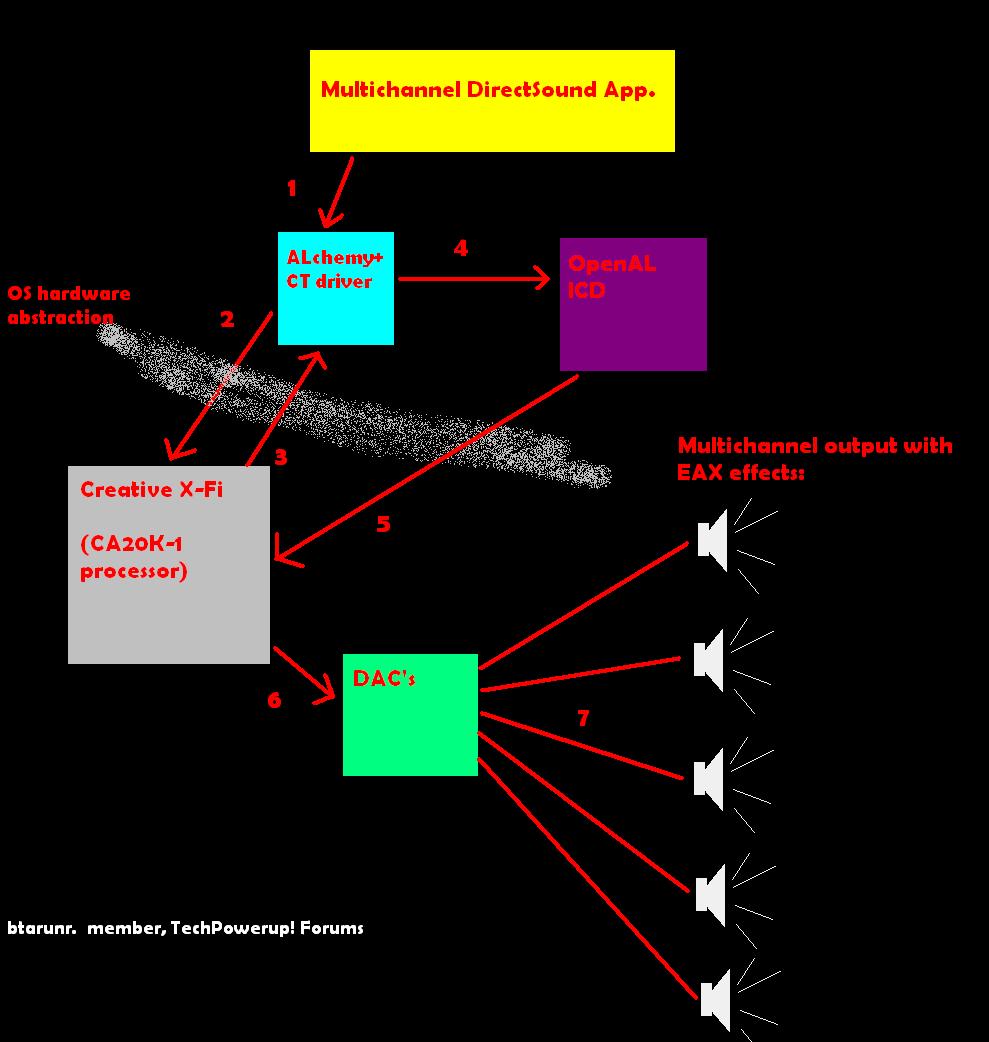
1. Audio data and EAX commands are sent to the driver + ALchemy extension that decode these DirectSound commands.
2. EAX processing to be done, data sent to the CA 20K1.
3. EAX processed, sent back in the raw PCM format, multiple PCM channels.
4. Multichannel PCM data sent to the OpenAL installable client driver in the form of OpenAL commands generated by ALchemy.
5. OpenAL has its own abstraction to the CA20K1 and since the CA20K1 has hardware support for OpenAL, the OpenAL data is sent to the sound card back as output, this time in multichannel PCM like any other OpenAL application.
6, 7: APU > DAC > Output.
~~~~~~~~~~~~~~~~~~~~~~~~~~~~~~~~~~~~~~~~~~
A Brief summary of X-Fi technologies and features:
X-Fi audio processor:
The X-Fi CA201K audio processor is manufactured on a 130nm process, is clocked at 400MHz and utilizes over 51 million transistors that are capable of producing over 10,000 MIPS (Million Instructions Per Second). In comparison, an AMD Athlon FX-57 is capable of producing 12,000 MIPS at 2.8GHz, and an Intel Pentium 4 Extreme Edition produces only 9,726 MIPS at 3.2GHz. The X-Fi audio processor features a SRC (Sample Rate Conversion) engine that is precise enough to be able to convert any audio resolution to any other audio resolution at near transparency with 136db SNR (Signal-to-Noise Ratio) THD+N (Total Harmonic Distortion + Noise) and digitally-matched recordings at rates from 44.1kHz to 96kHz. According to Creative's literature, the X-Fi audio processor is over 24 times more powerful than it's predecessor, the Audigy 2. For further reading regaring the capabilities of the X-Fi audio processor and how it's architecture works, visit: http://techreport.com/articles.x/8884
The X-Fi CA20K2 audio processor appears to be designed off the same manufacturing process as the CA201K APU, with the only major notable change being that the CA20K2 is a native PCI-E processor . . . meaning it will not have to rely on a PCIE translation chip for BUS communications, which would severelly impact audio processing latencies. Little is known of this APU at the moment, more info will be added as it surfaces.
CMSS-3D Virtual / CMSS-3D Headphone:
Creates up to 8 virtual speakers in order to achieve a surround sound effect for gaming and entertainment purposes where surround sound speakers are not available. The X-Fi algorithms upmixes the source and places the sound in it's most natural position. Basically, the hardware can break down a 5.1 channel source, upmix it, and reproduce that source into a 2 channel feed in such a way that it still sounds like 5.1. The capability of the CMSS-3D technology is more noticeable with headsets and 2.1 audio, and becomes increasingly harder to notice as one move up to 7.1 speaker setups. For a slightly more in-depth description of how CMSS-3D works, visit: http://www.pcper.com/article.php?aid=177&type=expert&pid=6
EAX 5.0 HD:
Environmental Audio eXtensions v5.0 High Definition is an assortment of DSPs (Digital Signal Processing) audio presets that utilizes the audio card's hardware filters to produce highly realistic and immersive sound, enviornmental effects, improved audio positioning, and a improved cinematic sound in games. This feature is inteded to add to the realism and overall effect of gameplay. The EAX 5.0 HD standard brings even more features to the table than the 4.0 standard did, and allows for double the voice count over EAX 4.0. For further reading regarding the capabilities and features of the EAX 5.0 HD design, visit: http://soundblaster.com/eax/abouteax/
X-RAM:
*All Creative X-Fi cards have some amount of onboard memory. The amount of onboard memory varies based upon the card model and revision, with RAM allotments ranging from 2MB to 64MB. The audio processor needs a small amount of memory for storing the APU BIOS, buffering, sampling and playback, and the more memory, the more voices and audio files the APU can handle at a time. The upper-end X-Fi models, are advertised as having 64MB or X-RAM, which really only means that they have 64MB as compared to lower models that may only top out at 32MB.
Found on the upper end cards, the X-RAM is 64MB of RAM native to the audio card, and dedicated soley for use by the X-Fi processor. In theory, the X-RAM would allow for improved gaming performance by unloading much of the audio memmory access from the system hardware and permitting the X-Fi to take over duties of moving audio files into and out of it's own onboard RAM. This would free up more space in the system RAM for use by the CPU, and transference of audio data would be minimized and audio files could also then be loaded and unloaded quicker by the audio processor. Although, only a handful of games currently support use of the X-RAM technology, and support by game developers has been slow to near non-existant. For further reading regarding how X-RAM works, visit: http://www.soundblaster.com/products/X-Fi/technology/x-ram/gamingXram.asp?page=3
24bit Crystalizer:
The 24bit Crystalizer is a processing innovation that is designed to enhance and restore lost information in the audio spectrum due to compression from an audio source, namely MP3s. The Crystalizer attempts to restore those sounds that are lost during compression to bring the MP3 audio sound back to or surpass it's original CDDA form. For gaming, the Crystalizer can bring not only a more crisp sound, but aslo enhance audio depth that can normally be lost through typical sound compression. Although the Crystalizer does, to some extent, do what it is advertised as being capable of, the actual validity of these claims has come under scrutiny. A rather interesting read regarding the Crystalizer technology, and what it's capabilities truly are, can be found here: http://www.digit-life.com/articles2/multimedia/creative-x-fi-part2.html
Ring architecture:
The X-Fi cards use an entirelly different architecture as compared to earlier Creative lineups and their competing cards. Whereas in a typical audio processing stream, components are arranged within a straight line. This type of architecture severelly limits both the number of audio voices that can be processed at a time, and also hampers the overall performance in regards to the amount of time it takes for that voice to be processed from source to playback. The X-Fi's make use of what Creative calls a "Ring BUS" architecture, where all processing components on the PCB BUS are arranged like that of a ring. Each component in the ring can pull the processed audio voice, manipulate it, and place it back into the ring for the next component to access. This design, in turn, allows for thousands of audio voices to be processed simultaneously, and to also be processed faster. If a component does not need to manipulate an audio voice, it never has to come into contact with the processed stream.
btarunr has illustrated in a fairly easy to understand diagram how this architecture works:

~~~~~~~~~~~~~~~~~~~~~~~~~~~~~~~~~~~~~~~~~~
Creative X-Fi Sound Blaster Models
Sound Blaster X-Fi Xtreme Audio PCI
The Xtreme Audio is the cheapest of the X-Fi lineup as far as price in concerned. If you’re in the market for a simple audio adapter card, and music and videos is your thing, this would probably be the best choice. Not really recommended for serious gaming, considering this card is designed more for the home entertainment market, and lacks some of the gaming features and support that stand out on the other models. Features CMSS-3D, 24-bit Crystallizer.

Sound Blaster X-Fi Xtreme Audio PCI-Express
This card offers the same features as the Xtreme Audio PCI, although it utilizes a PCI-E x1 interface. One of the few pieces of hardware on the market that make use of the PCI-E x1 slots so common on motherboards. This might be alright for mini-towers where space is a major concern, or anyone looking for a solution for a multi-GPU rig. Due to poor reviews, and potential problems with multi-GPU setups and mid-range motherboard chipsets, I honestly can’t recommend this card, yet.

Sound Blaster X-Fi Xtreme Gamer PCI
The Xtreme Gamer is targeted specifically at the gaming market, and also serves as a great card for video and audio playback, and audio “tweaking”. Not recommended if you’re looking for a card that can handle serious audio creation. This Xtreme Gamer features Creative’s CMSS-3D, support for EAX 5.0HD, and the 24-bit Crystallizer.

Sound Blaster X-Fi Xtreme Music PCI
The Xtreme Music was targeted at audiophiles in general, and also has features catered towards the gaming enthusiast. This model was supposed to pick up where the Xtreme Gamer left off in the line-up, by offering better audio creation support. I believe this card, though, has been superceded by the X-Fi Platinum.

Sound Blaster X-Fi Platinum
The X-Fi platinum is a package deal. It comes with the Xtreme Music PCI card, plus adds the X-Fi I/O Front Panel Drive and a X-Fi Remote Control. The Front Panel Drive utilizes a 5.25” drive bay, and allows for easy input and output jack access and adjustable volume control.

Sound Blaster X-Fi Xtreme Gamer Fatal1ty Pro PCI
The XGFP is the flagship of Creative’s line-up, boasting full-feature support in all 3 areas (gaming, entertainment, audio creation), and also bringing in 64MB of X-RAM, power indicator LEDs, I/O support, and more. This card is targeted at the audiophile, and those who are looking for the absolute best sound card solution. Until the Auzentechs were released, this was the definitive audio solution. Still capable of competing and surpassing the lower-end models offered by Auzentech, though, I personally recommend this card to anyone looking for the best solution possible, while still being on a budget.

Sound Blaster X-Fi Platinum Fatal1ty Champion
This package includes the Xtreme Gamer Fatal1ty Pro PCI card, plus the I/O Front Panel Drive and remote.

Sound Blaster X-Fi Elite Pro
This package includes the flagship X-Fi card, plus the I/O Console and remote. The I/O console offers the same connect ability that the Front Panel Drive offers, but instead attaches to the back of the card and can be placed remotely. The I/O Console is targeted more at a home entertainment setup, in this respect. The Elite Pro sound card is the current highest audio playback quality card in the lineup, and is a completely different beast from the rest of the X-Fi models, right down to PCB components and component layout.

Sound Blaster X-Fi Titanium Fatal1ty Professional
The most recent X-Fi branded card to enter the Sound Blaster line-up, the Titanium is a native PCIE x1 soundcard; being native PCIE, there is no additional audio processing latecny that would be introduced with a PCIE logic translation chip. The card boasts the same audio quality specifications as the Xtreme Gamer Fatal1ty cards, and improves upon that with the addition of an EMI shield. This card, though, drops support for the AUD_LINK to the X-Fi reciever from the PCI bracket, and instead adds optical (TOSLINK) support, as well as offering 5 analogue jacks instead of 4 (subwoofer is now a seperate channel). The Titanium is also the first X-Fi card that allows for Dolby encoding as well.

Sound Blaster X-Fi Titanium Fatal1ty Professional Champion
This package option offers the X-Fi Titanium PCI-E x1 soundcard, and the new X-Fi Titanium Front Panel I/O bay drive. Of note, the new I/O bay drive will readily fit a 3.50" bay, and also includes an adapter to fit a 5.25" bay, allowing for better installation versatility as compared to the earlier X-Fi I/O bay drives. The new drive has seriously timmed down connectivity, though. The 3.50" drive itself offers headphone-out and microphone-in mini-jacks, a volume knob, and a mode selector knob (>correction?<); the 5.25" adapter adds two RCA line-outs to the drive.

Non-Creative X-Fi equiped cards:
Auzentech X-Fi Prelude 7.1
Auzentech have made a name for themselves for selling extremelly high-quality audio cards that offer superior versatility and superior audio quality as well. Combined with excellent customer and technical service, Auzentech have cemented themselves within a niche in the audio card market. The Prelude is the first non-Creative owned audio card to carry Creative's hardware. The Prelude boasts the X-Fi CA201K APU, and brandishes the typical high-quality components that Auzentech have become known for. Amidst the upper-end DACs, ADC and OPAMPs, the Prelude even even boasts the ability for the user to swap OPAMPs as they see fit - giving the consumer a DIP socket instead of hard-soldering the OPAMPs to the PCB. These cards feature the audio processing performance that the X-Fi APU has become known for, and offer all the hardware features of Creative's cards. They also support Dolby decoding and encoding as well.

Auzentech X-Fi Home Theater 7.1
A new card still in the works from Auzentech, again featuring a X-Fi APU. The card will make use of a PCIEx1 slot (rumored to make use of the new CA20K2 native PCIE APU), and will offer HDMI 1.3 support. More information and an image will be added as they become available. This card is not yet on the market, scheduled for release early 2009.

For owners who have the X-Fi remote found with the 5.25" bay front panel and the I/O Console, 3rd party software exists that offers better compatibility and functionality over Creative's bundled software:
I have just bought this program-
http://melloware.com/products/intelliremote/
Manual-
http://melloware.com/products/intelliremote/Intelliremote User Manual.pdf

It is called intelliremote,heres a quick summary-
Intelliremote is a software program that replaces the cumbersome Creative Remotecenter software that is bundled with Soundblaster Live!, Audigy, and X-Fi models. Intelliremote also replaces the EHTray application for Microsoft Windows Media Center. Creative and Microsoft had an excellent idea bundling an infrared remote control with their products...it's just to bad the software doesn't even do what you want it to do!
Intelliremote is roughly 900K in size, and it packs the punch of Microsoft's Intellitype instructions. So any application can be controlled with the IR remote that "listens" for Intellitype messages such as ITunes, Winamp, BSPlayer, Foobar2000, VLC, Windows Media Player, and many more! Each remote key can be assigned to an instruction, a mouse event, application event, or even a windows automation script.
~~~~~~~~~~~~~~~~~~~~~~~~~~~~~~~~~~~~~~~~~~
Common Problems and possible resolutions
Poor Audio Quality
It goes without saying, but, if audio playback is poor quality, or not what you expected - keep in mind that your speaker setup has more to do with audio quality than the sound card does. You can have the best audio card in the world, but it can still sound like total butt running on a cheap set of lacklustre quality speakers. Same holds true for headsets. Some thoughts here:
~Built in monitor/keyboard speakers - are fine for browsing the net or dealing with anything else that only has poor quality encoded audio to begin with. But, if you intend to game or watch movies or anything else with good sound . . . you need to get a set of real speakers.
~Flat panel speakers - are alright, and even though the high end models can still sound very nice, they have a hard time producing very low tones and usually call for a subwoofer to produce any type of low tone at all. They're great if you care about having that sleek, professional look, but, in my own opionion - they still don't cut it when it comes to high audio quality.
~Cone speakers - everything from bookshelf speakers to satellite speakers, cone-based will give you the best audio quality possible. Being fully capable of rendering tones across the frequency range, there really is nothing comparable. Granted, a good setup will still require a subwoofer for that deep bass playback found in most movies and in modern music - but if keeping the neighbors awake with a subwoofer isn't your thing, cone speakers are still capable of enough bass to keep you happy. The biggest thing to look out for when choosing cone speakers, though, are the materials that are involved with their assembly. Cheap sets of cone speakers will still sound horrible, compared to high quality ones.
If you have any questions concerning your audio playback, or how better to tell if your speakers really are the culprit of poor audio quality - either PM me or post a question in this thread.
~~~~~~~~~~~~~~~~~~~~~~~~~~~~~~~~~~~~~~~~~~
Snapping, Crackling, Popping
This is the single most common problem with X-Fi cards, especially the early models. These sounds are various forms of audio clipping which occur when the X-FI sends a BUS data request to the slot controller, and that data request is not serviced in a timely manner. This in turn leads to gaps in the audio playback which can manifest itself in the form of snapping, crackling, popping, screeching, etc. This condition can also arise when the X-Fi's ability to access system memory is slowed down or interrupted. There are a few possible causes and quite a few different possible soultions to this issue:
1.) nVidia nForce 4 chipsets, VGA adapters:
These problems can possibly be cause by nVidia hardware present in the system, specifically, nForce 4 chipsets. Othertimes it can be cause by nVidia VGA adapters. This isn't to say that anyone who owns an nVidia VGA adapter or motherboard with an nForce 4 chipset will have these problems. If you own any such hardware and are experiencing problems; first, make sure your motherboards BIOS is as up-to-date as possible, and that any installed nVidia VGA BIOS is also up-to-date. It is possible that you have an early model X-Fi, and may want to inquire with Creative if they possess a solution for your card (meaning: if they can RMA it - the audio controllers on the later models don't seem to conflict with nVidia hardware as often). Aside from the above options, there aren't many supported solutions to for this condition, although one of the soultions listed below may help.
2.) Pentium 4 processors:
This is a somewhat uncommon problem, and I'm not sure why a Pentium 4 would cause this either, but I've run across a couple of complaints here and there that seem to justify this. It seems to be more of an issue with the lower end, slower clocked Pentium 4's and the P4 models that suport HyperThreading. Overclocking the CPU seems to resolve this issue. If you're not comfortable, or not willing to attempt to overclocking the CPU, check for motherboard updates first. Possibly turning off HyperThreading may help resolve the issue, also.
3.) General hardare conflicts:
Owners of high-end VGA adapters, high-end hard drives, and other high-end hardware may recieve this problem. If you think a high-end component installed in your system to be the cause, check for any motherboard BIOS updates for your system, any possible VGA BIOS updates, and check for any updated drivers for your hardware. If after updating any out-of-date hardware drivers you're still experiencing problems, other possible soultions are listed below.
4.) Insufficient system memmory:
Not enough RAM can also cause this problem, if you're currently only running 512KB of RAM, it would be a wise idea to go ahead and upgrade to at least 1GB of RAM anyhow. As always, check to make sure your motherboard BIOS and hardware drivers are up-to-date. If you're running 1GB or more, try closing out unecessary programs that may be running in the background, and any unecessary programs running in Windows taskbar. If the problem goes away, or doesn't happen as often as before, you might want to consider upgrading your system memmory.
5.) Slow system memory:
Installed RAM that is clocked too slow, or with too high of latencies can also be a cause. If hardware permits, install your RAM in Dual-Channel mode, as this allows for higher memory bandwidth and speed. Check to make sure your motherboards BIOS and hardware drivers are up-to-date. If you feel comfortable doing so, you can try to overclock your system memory some, lower the memory latencies, or increase the CPU BUS. It may be necessary to purchase new memory rated at a higher speed - especially if your current memory is running slower than the system BUS and cannot be clocked higher.
6.) Insufficient audio processor cooling:
Another possibility is that the X-Fi is becoming hot enough to start interfering with it’s ability to carry out commands. Again, make sure your motherboard BIOS and hardware drivers are up-to-date. You can estimate your audio processors temperature by hand while it’s in heavy use (when the problem is noticed). If you put your fingers on the audio processor and it feels very warm or hot to the touch, you’re probably in need of better cooling. If your X-Fi doesn’t have an installed heatsink, you can purchase a small northbridge cooler, and using thermal paste or thermal tape, install it onto the X-Fi processor. If your X-Fi came with a heatsink installed, you can attempt to lap the heatsink (although difficult to do as the factory heatsink is installed with thermal paste), or attempt to install a northbridge fan (also a bit difficult, but can be done).
Other possible snapping, crackling, popping resolutions:
7.) After updating the X-Fi drivers:
If you experience audio clipping (or any other issue) after installing updated X-Fi drivers, this is usually a good sign that other hardware drivers are out-of-date, or your motherboard's BIOS is out-of-date, and that the X-Fi drivers were writting around certain hardware updates. Check for updates as necessary. If the problem still persists, it maybe due to other hardware issues. You can attempt some of the other resolutions I've posted here, but your best bet would probably be to contact Creative's Tech support first (in case there is an issue with the new drivers or otherwise).
8.) In games:
If audio clipping only happens in certain games, and not others, it's possible that the game is trying to load more audio samples than the audio processor can handle (especially possible if the game automatically detects audio hardware). Be sure you have the X-Fi processor set to "Game Mode" in the audio console, first. Also, check to make sure that your playback resolutions are set at 44.1kHz. If playback rates are already set at 44kHz, and if the game has an audio option menu, try adjusting the number of audio channels if possible. If this isn't possible, you might need to do some research on the game and determine if there are any command line audio options or not. If the game employs a "command console" where you can directly change the games behaviour (i.e. Doom3, Quake4), console commands might exist that would allow you change the games audio setup.
9.) Adjusting the PCI slot clock speed:
Some motherboards automatically set the PCI slot clock speed based upon the CPU clock speeds. This can lead to problems with certain hardware not functioning properly. If your motherboard BIOS supports adjusting the PCI clock frequencies, you should first set the clock at the PCI native 33.3MHz. If the problem still persists, you can attempt to increase the PCI clock speed. Be careful to not raise the PCI clock speed to high, as you could potentially damage your hardware. Also of note, if your BIOS does support changing the PCI clock, but does not list a clock speed for each individual PCI slot, and changes to the clock speed in BIOS will affect all installed PCI hardware. Be careful.
10.) Adjusting the PCI latency:
Some motherboards will automatically set the PCI slot latency timer for each piece of installed hardware. Raising the PCI latency timer for the X-Fi can resolve audio clipping issues. If your motherboard supports adjusting the PCI latency timing, try raising it in increments and re-checking to see if the problem goes away. Some motherboards support changing the latency of each individual slot, and others only offer an adjustment that affects all PCI slots. If you raise your latency timings too high, other PCI devices that require frequent access to the PCI BUS could potentially lose data and cause the system to become unstable. Be careful.
11.) Manually setting the X-Fi IRQ:
Be warned that changing a device IRQ to an incorrect or conflicting setting could lead to either the device not functioning properly in Windows, or lead to entire system instability. Considering newer hardware and how device resources are implemented and controlled in Windows XP, it’s rare to have an IRQ conflict between devices.
If a hardware resource conflict arises after installing new hardware, make sure that the drivers for the new hardware are up to date, first. You can also try to un-install and then re-install the hardware drivers. You may also need to un-install the new hardware drivers, and the X-Fi drivers, and attempt a re-install from there. Yet another option is to un-install the new hardware drivers and the X-Fi drivers, then change what PCI slots they are installed into, then re-install the drivers.
There are a couple of methods for going about changing a device’s interrupt request. To start with, you’ll need to actually see what IRQ’s are assigned to what devices in Windows, and see what IRQ’s are available. Go to Start>Settings>Control Panel>System, click on the ‘Hardware’ tab, and then click on the “Device Manager” button to open Windows Device Manager. In Device Manager, open the ‘View’ menu, and select “View Resources by Type”, and then expand the ‘Interrupt Request (IRQ)’ tree. Find the listing for your X-Fi, and make sure that it is the only device assigned to one specific IRQ. If so, any audio issues are 95% probably not because of the devices IRQ assignment. Although, it isn’t unusual for more than one device to be sharring an IRQ channel, certain devices (i.e. the X-Fi) function better when not sharring this resource.
Note: If you can change the PCI slot IRQ in BIOS, and the changes aren’t reflected in Windows Device Manger, you may have to manually change the IRQ settings within Windows itself – you will have to be logged into Windows as an Administrator or Owner to do so.
If there is another device sharring the same IRQ, or a potential conflict, or you just want to set it anyways, make sure the device is not currently in use. Right click on the device listing and open up ‘Properties’ then click on the ‘Resources’ tab. If possible, de-select the “Use Automatic Settings” checkbox, and then select the resource you want to change, the device IRQ (you may have to change the ‘Settings Based On:’ box to a different basic setting to make any changes), and click on the “Change Setting” button. In the new window that opens, use the scroll arrows to set the device IRQ and make sure you set it to a value not currently in use by another device (as in, a number either not listed in Device Manager, or one that is listed as ‘not currently in use’)!!
If you can’t make any changes to the X-Fi IRQ resource, and the device IRQ is conflicting with another device, you can attempt to change the conflicting device instead. The idea is to try and free up the specific IRQ channel for only the X-Fi card.
After changing the device IRQ, you MAY have to change various other resources (I/O Range, DMA, etc.) to enable the device to continue to function properly – I’m not going to get into the various wonders involved with correctly doing this and troubleshooting those changes, if you wish to experiment, feel free to . . . but heed the warning I posted at the beginning of this thread!
If you don’t have access to changing the device(s) IRQ, there isn’t much further you can go with this . . . one option is to uninstall the devices from Windows, re-boot, and hope Windows allocates the IRQ channels a little better. You can swap the components from one PCI slot to the next. Your next option is to change the OS HAL from ACPI to Standard (NOT RECOMMENDED!), which will require a re-install of Windows, or just attempt to do a clean Windows install by itself. If you do re-install Windows, upon initial boot up, follow the information I posted about a clean install of Windows.
12.) Hardware Acceleration disabled
Disabling Hardware acceleration can also cause audio clipping in certain programs. Make sure your hardware drivers are up to date, and if you are encountering problems with a specific game, make sure the game is patched to the most current version. Also, ensure that you are running the most current version of DirectX and OpenAL. To the best of my knowledge, audio hardware acceleration is disabled in Windows Vista (could a Vista/X-Fi owner please verify this for me?). In Windows XP, verify that hardware acceleration is enabled by going to Start>Settings>Control Panel>Sounds and Audio Devices; under 'Speaker Settings,' click "Advanced," in the new window that pops up, click the 'Performance' tab, and make sure the hardware acceleration slider is all the way to the right. If for some reason, the slider keeps being set all the way back to the left, there may be a hardware conflict, see below. In some programs, full acceleration has been known to cause audio clipping also, you may need to move the slider to the left one notch, if that proves unsuccessful, try two. Very rarely will turning off audio acceleration cure an audio clipping concern. You may also need to attempt to lower the playback quality in the same 'Performance' tab, and verify that playback resolution is set to 44kHz within the X-Fi Audio Console.
13.) Incorrect driver version for installed OS
If you notice various audio clipping or other odd issues after installing the update driver from Creative's website, or after updates from Windows/Microsoft Update have been installed, and if you are currently running Windows Media Center Edition 2004/2005, there is a possibility that the most current driver version, 2.09.0007, will not function correctly, leading to various issues, including audio clipping, loss of EAX and hardware acceleration, non-functional CMSS-3D (either won't work at all, or will produce audio clipping), and possibly other issues. Note: it is possible to have this driver installed on a MCE OS without your knowledge, as it is offered through Windows/Microsoft Update. It is listed under the hardware section, and you may have to go to MS Update, uncheck it and hide it so that there is no chance that it will be installed. Your best bet would be to just stick with the audio drivers supplied on the instalation CD. If you did install the updated drivers, rolling back the drivers in Windows Device Manager won't necessarily fix the condition, either - it will call for a clean install of the X-Fi drivers, see below for the procedure. If I notice an update has been posted by Creative specifically for MCE, I will post it in this thread.
~~~~~~~~~~~~~~~~~~~~~~~~~~~~~~~~~~~~~~~~~~
No EAX, OpenAL, or hardware acceleration
Some users may experience a lack of hardware accelaration with the X-Fi, which will also disable EAX and OpenAL compatibility on the card. Hardware acceleration can be verified by use of the DirectX Diagnostic tool (which is installed to the Windows/System/ folder, DxDiag.exe), or by going to Start>Settings>Control Panel>Sounds and Audio Devices - under 'Speaker Settings' click "advanced," click the 'Performance' tab, and verify the hardware acceleration slider is all the way to the right. To the best of my knowledge, Windows Vista does not support audio hardware accelration (could a Vista/X-Fi owner pleasy verify this for me?). First, make sure that your hardware drivers and motherboard BIOS are up to date. Also make sure that the most current version of DirectX and OpenAL are installed.
1.) USB hardware conflict
I still don't understand why this can be a cause of disabled hardware acceleration, I think it has something to do with the X-Fi's ability to interface with X-Fi USB devices, not 100% sure . . . In some instances, having a USB peripheral plugged in can disable the X-Fi's hardware acceleration capabilities, EAX functions, and/or OpenAL support. Certain products have been more well known at causing this condition, most specifically certain brands of gaming keyboards and optical mice. Certain brands of USB webcams can cause issues, also. Note, for this condition to occur, the device does not necessarilly have to be turned on, nor have drivers installed; just the fact of having the USB device plugged in can disable hardware acceleration. This is kind of a process of elimination if you suspect a USB device to be the cause (especially if the condition starts to occur after new USB hardware upgrades). First, remove all USB devices (if you're currently using a USB keyboard or mouse, you'll need to attach a PS2 or other non-USB peripheral) and boot the computer, then check if hardware acceleration is enabled and stays enabled. If so, power down, install one USB device, reboot and recheck. Keep repeating until you have no hardware acceleration after attaching a device. To fix this issue, first check if there are any updated drivers for your USB component. If you are currently up-to-date, you will need to remove the device drivers, and unplug the device. Then completely remove the X-Fi drivers {{{{remember to add how}}}}. Re-connect and re-install your USB device drivers, and then re-install the X-Fi drivers. If this doesn't fix the problem, unless you don't mind leaving the device unplugged when not in use, you may need to contact Creative's Tech Support for further assistance.
2.)
~~~~~~~~~~~~~~~~~~~~~~~~~~~~~~~~~~~~~~~~~~
Audio static or other anomolies
If you experience what sounds like faint static, a whirring or whining type of noise that changes frequency and pitch, and isn't always loud enough to drown out the audio sample itself, it's possible that the X-Fi is picking up some form of electronic noise or radio noise, which for pure simplicity's sake I will refer to here as EMI.
Certain components (and especially older ones) can generate electronic noise that highly sensitive audio equipment can pick up on and which will manifest itself as some form of white noise over audio playback.
Also, some of the X-Fi audio clipping issues can sound very similar to EMI, if after attempting various soultions for the audio clipping issue without success, there could be an EMI issues instead.
Possible internal sources:
*A high powered, faulty or failing PSU - it's possible that a cheaply engineered and manufactured high-powered PSU can produce EMI. It's also possible for any PSU to produce EMI if it has become faulty or starting to fail. If possible, swap PSU's and if the noise is no longer present, you've found your culprit.
*VGA adapters - some VGA adapters have been known to produce a small amount of EMI, most likely with cheaply built units, or high-powered ones. Try to install the X-Fi in a slot furthest away from your VGA adapter, if the noise either sounds noticeably reduced or goes away, the VGA adapter is to blame. Either replace the unit, or contact the hardware manufacturer for a possible RMA.
*Wi-Fi adapters and routers - simply because of the very nature of their design. These devices operate by producing a certain RF signal which in and of itself is a form of EMI. These devices are more likely to potentially interfere with the X-Fi itself, or nearby speaker wire. Although the possibly of EMI is more prominent with cheaply made units, even reputable units could potentially cause problems. If you are using a PCI wireless adapter, attempt to install it and the X-Fi as far away from each other as possible. With speaker wire, either but shielded cable, or attempt to route wires away from these devices. If your Wi-Fi adapter makes use of an antenna and is attached to an expansion slot card by means of a cable, attempt to place the antenna as far away from the PC case as possible.
*Other system hardware; CPU, motherboard components, DC brush motor fans, HDDs - although at the bottom of the list, that doesn't mean they are to be ignored. Certain hardware components can produce enough EMI to be noticeable. High-clocked CPUs due to their higher operating frequencies. Specific motherboard components, usually the Northbridge chipset or Southbridge chipset. DC brush operated fans, especially cheaper units - the brush design generates a magnetic field as the motor operates. For the most part, cheaply manufactured components tend to be more of a problem. Attempt to install the X-Fi into a slot furthest away from suspected components
Outside EMI sources:
*Appliances - most home appliances can generate significant EMI, microwaves, blenders, refrigerators, freezers, washing machines, dryers, dish washers, garbage disposals . . . specifically, any appliance that utilizes some form of high powered motor to operate. If your PC is relatively close to a suspected appliance, attempt to set the PC up else where. If the EMI goes away, then you know the appliance was to blame. Also, if an appliance is generating enough EMI to be picked up inside the case by the X-Fi, that EMI signal could potentially be interfering with other components.
*Automobiles - why you would have a PC within a very short distance of a running automobile I couldn't imagine . . . but, newer automobiles generate massive amounts of EMI, especially motors that use some form of electronic fuel injection. The ignition coils under the hood of an automobile are capable of generating voltages anywhere between 10,000 - 80,000+ volts. These extreme operating voltages can generate an EMI signal that even the most impervious appliances could pick up on.
*Neighboring sources - if you live next to a power plant, a transformer park, broadcasting tower, sewage pump station, etc. you could be picking up EMI from these utilities. Not all that much you can do here . . . maybe you can try petitioning your local city/county to relocate their public utilities . . . or you can move further away . . . maybe mod an old 3' refrigerator to ecase your PC, but that will present cooling concerns . . . unless the refrigerator still works

Possible fixes for external EMI:
*Shield the system by use of the case - In it's basic form, the PC case in itself will act as an EMI ground, but can only do so when fully enclosed. Make sure the side panels are installed.
*By use of an antenna - this will look odd, though . . . go to an automotive junkyard or parts store, and find a vehicle antenna that is shielded (it will look like it has a wire wound around the antenna, usually under a black coating). Find a bolt or nut that fits the antenna's fastener from a hardware store, then drill a hole in the top of the case and install the antenna.
*By use of shielded cable - if you don't want to bork your case's good looks with an antenna, buy some shielded cable from a local electronics store (shielded speaker cable is alright), then string the cable along the inside of the case. It works best if you can use one continuous length of cable, running along the corners of the case - from the top to the motherboard side panel to the front panel to the bottom, etc. You can use tape or whatever suits you to attach the cable to the case itself. At the very end of the cable, expose the wires from the insulation, and attach them to the case by use of an already installed case screw (loosen the screw, wrap the wire around it and tighten - only one end of the cable need be grounded).
~~~~~~~~~~~~~~~~~~~~~~~~~~~~~~~~~~~~~~~~~~
Modding
Keep in mind that any direct physical modification to the hardware that is intended to, or does, change or alter the way in which the hardware was initially designed to operate will completely void any warranties. That being said, proceede with any modifications to the card at your own risk.
Cooling
Considering the power that the CA20K1 APU is capable of, cooling should be a primary concern. Most newer revision X-Fi cards come with a heatsink atop the APU, which is a good start. If your X-Fi does not have a heatsink on the APU, I fully recommend installing one! Not only will you prolong the life of the APU and further extend the life of the capcitors, the card will process better, and should lead to a very slight increase in audio quality.
For the APU, and decent chipset 40mmx40mm heatsink will do, preferably of the kind that uses thermal tape to affix it. There are no mounting holes near the APU for the kinds of heatsinks that use a "solid" mount. I also recommend using a copper heatsink over aluminum, as copper provides better EMI/RFI shielding qualities. Another decent recommendation, after making sure the heat sink is firmly attached, would be to install a 40mmx40mm fan as well.
Other PCB components I recommend adding a heat sink to: the DAC, ADC, OPAMPs, DRAM modules, and mosfets
For other PCB components, you can use mosfet style passive heat sinks (they're very tiny squares), and for the DRAM modules, you can use DRAM style passive heat sinks.
Front Panel Connectivity
Although not really modding, I thought I'd include it here. Unless you have a newer revision card which actually makes use of an AC97/Azalia style 10-pin terminal, you'll have to jump a couple of hurdles to have front panel support.
For starters, the X-Fi does have a front panel out connector, but it's proprietary and doesn't interface easily with other connectors . . . plus, information as to what each individual pin on the terminal goes to has been scarce. Thankfully, the X-Fi makes use of the same connector and pinout as the older Auidgy cards do.
The initial legwork has been already been taken care of by another user a long while back, and the information on how to add basic connectivity support for the Audigy cards can be found here: http://audigy2zshowto.blogspot.com/
To make use of the proprietary connector on the X-Fi without having to do some extensive soldering/modding, you'll need to purchase the following components from Digi-Key:
455-1127-1-ND - crimp style female wire terminals to fit the proprietary 10-pin connector
WM2522-ND - 10-pin AC97/Azalia style terminal header(if you want to make an "adapter" style cable similar to the one in the link above)
WM2515-ND - crimp style male wire terminals to fit the AC97/Azalia style terminal header (if you want to make an "adapter" style cable similar to the one in the link above)
455-1151-ND - 10-pin proprietary style connector to fit the 10-pin header on the X-Fi
This is the pinout legend for the 10-pin proprietary connector:
1 2 3 4 5 6 7 8 9 10
1 - Analog ground
2 - Left out
3 - Audio backpanel mute (grounded with headphone jack plugged in - I think this is Left Return)
4 - Right out
5 - same as pin 3 (I think this is Right return)
6 - Mic In from front panel
7 - no pin
8 - VREF Mic out (voltage reference for mic)
9 - Mic In mute (ground when mic isn't plugged in, +12V with mic plugged in)
10 - Audio Detect (ground when headphones plugged in, not normally used)
As I mentioned, the X-Fi uses the same exact setup as the Audigy . . . but what if you want further HD support and connectivity? As best I can tell and have tested with my card, this setup will work:


The connector representing the terminal on the card is number from 1-10; I wrote the legend so that all one needs to do is remove the wire from your AC97/Azalia connector, and insert them into the new 10-pin connector in the order listed.
As I've tested with my card, I have full HD support through the front panel, and the card will also mute rear output when a jack is inserted. The only capability that I don't seem to have, is that of the audio console changing speaker settings to "headphones" . . . I think this might only be supported with use of the X-Fi 5.25" bay front panel.
EMI/RFI Shielding
comming soon
Capacitor, OPAMP and other PCB component upgrading
comming soon
~~~~~~~~~~~~~~~~~~~~~~~~~~~~~~~~~~~~~~~~~~
XSS Members:
- imperialreign
- malware
- btarunr
- Morgoth
- thegave
- department76
- Ninkobwi
- happita
- Davidelmo
- Craigleberry
- Shadowfold
- ElementImage
- Kursah
- hbkl
- DaveK
- Mussels
- _jm
- pabloc74
- Cold Storm
- CyberDruid
- randomflip
- hayder.master
- J.M.D.
- rpsgc
- majestic12
- sNiPeRbOb
- Swamp Monster
Last edited:







